The Chinese Meteorological Society
Article Information
- LI, Tim, Bin WANG, Bo WU, et al., 2017.
- Theories on Formation of an Anomalous Anticyclone in Western North Pacific during El Niño: A Review. 2017.
- J. Meteor. Res., 31(6): 987-1006
- http://dx.doi.org/10.1007/s13351-017-7147-6
Article History
- Received October 5, 2017
- in final form December 1, 2017
2. International Pacific Research Center and Department of Atmospheric Sciences, School of Ocean and Earth Science and Technology, University of Hawaii at Manoa, Honolulu, HI 96822, USA;
3. Institute of Atmospheric Physics, Chinese Academy of Sciences, Beijing 100029, China;
4. University of Chinese Academy of Sciences, Beijing 100049, China;
5. Naval Postgraduate School, Monterey, CA 93943, USA;
6. Institute of Atmospheric Sciences, Fudan University, Shanghai 200433, China
The El Niño–Southern Oscillation (ENSO) is the greatest interannual variability in the earth climate system. While major convection, circulation, and sea surface temperature (SST) anomalies associated with the ENSO are confined in the tropics, its impact is global (Rasmusson and Carpenter, 1982; Philander, 1990; Webster et al., 1998). For example, during its mature winter, El Niño can remotely affect climate in North America, through an atmospheric teleconnection pattern named “Pacific–North America (PNA)” pattern (Wallace and Gutzler, 1981). The essential dynamical process behind this teleconnection pattern is energy propagation of stationary Rossby waves emanated from the tropics to midlatitudes along a “big circle” (Hoskins and Karoly, 1981).
Different from northern winter, El Niño teleconnection pattern in northern summer is quite different, due to poleward shift of the upper tropospheric jet (Zhu and Li, 2016). A recent study suggests that El Niño may indirectly affect North America in summer through an Asia–North America (ANA) pattern by affecting East Asian rainfall along the Meiyu/Baiu front (Zhu and Li, 2016). The El Niño teleconnection to South Asian summer monsoon has long been recognized (Webster et al., 1998; also see Li and Hsu, 2017 for a recent review on this topic). A simultaneous significant negative correlation was found between the Indian summer monsoon rainfall and the Niño 3.4 index (Webster and Yang, 1992). Such a negative correlation, however, occurs primarily during the summers of El Niño development (Li and Wang, 2005; Li, 2010), during which the amplitude of SST anomaly (SSTA) in the eastern equatorial Pacific has attained a relatively large value (Fig. 1). This is in a great contrast to El Niño decaying summers when the composite SSTA amplitude in the eastern equatorial Pacific is nearly zero. However, during that summer, significant positive rainfall anomalies occur along the Meiyu/Baiu front (Fu and Teng, 1988; Huang and Wu, 1989; Zhang et al., 1999; Wang and Li, 2004; Liu et al., 2008; Wu P. et al., 2017; Zhang et al., 2017), an important large-scale atmospheric system in East Asia in early summer. The Meiyu/Baiu front is nearly zonally oriented, covering a large portion of the East Asian region from the middle–lower reaches of Yangtze River in central China all the way to south of Japan (Tao and Chen, 1987; Tao and Zhang, 1998; see Fig. 2 of Zhou et al., 2009a for a review). After a strong El Niño, the Meiyu/Baiu rainfall often becomes much more intense. A typical example is the disastrous flood along the Yangtze River in summer 1998, 6 months after a super El Niño episode in December 1997. It has been a puzzle for many years for climate researchers in East Asia as how an El Niño could exert a “delayed” impact on monsoon rainfall over East Asia, six months after the peak phase of El Niño when the SST in the equatorial eastern Pacific is nearly normal (Fu and Teng, 1988; Shen and Lau, 1995).
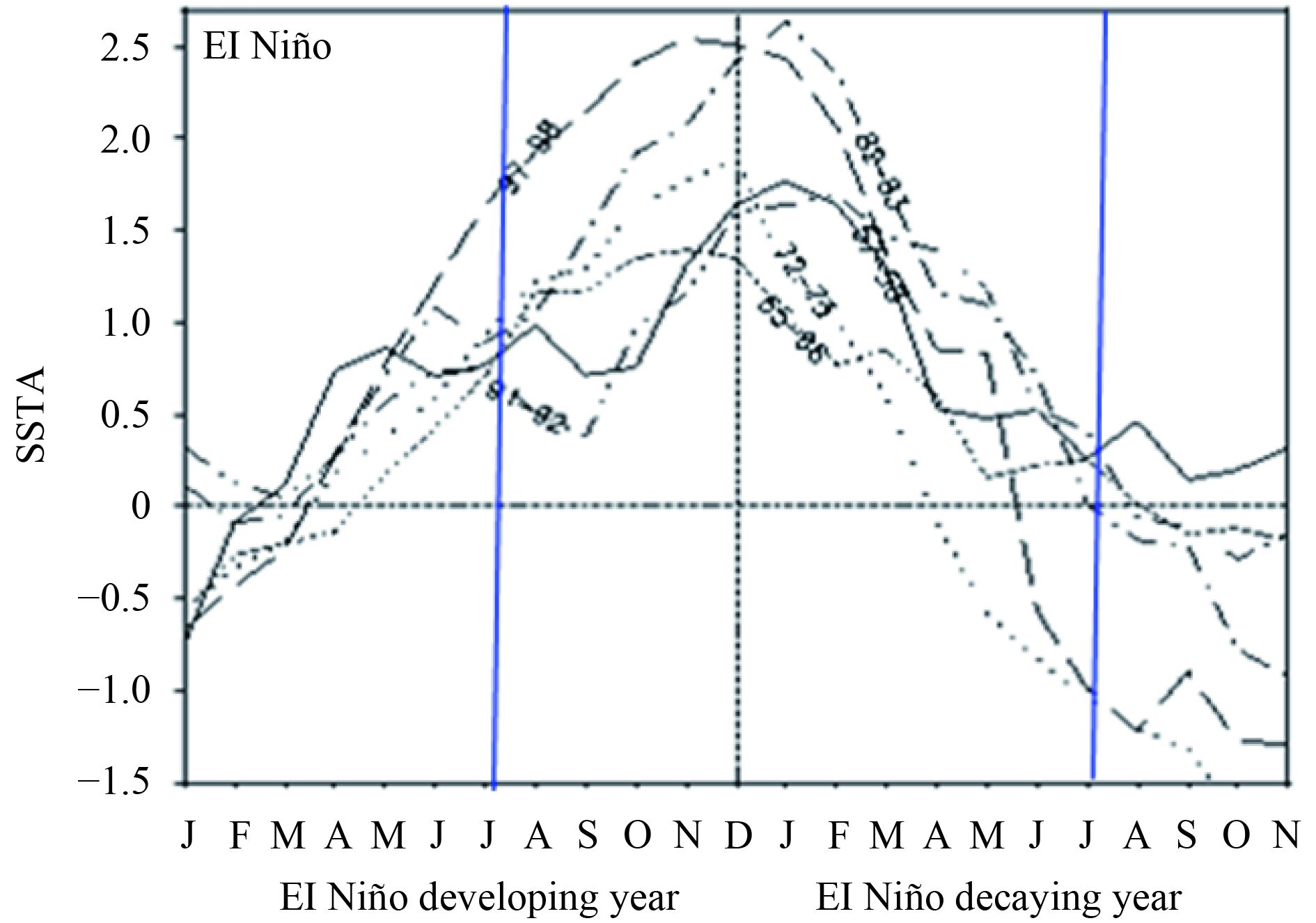
|
| Figure 1 Time evolution of Niño 3.4 SSTA (°C) for individual El Niño events during 1956–2000. From Wang et al. (2000). |
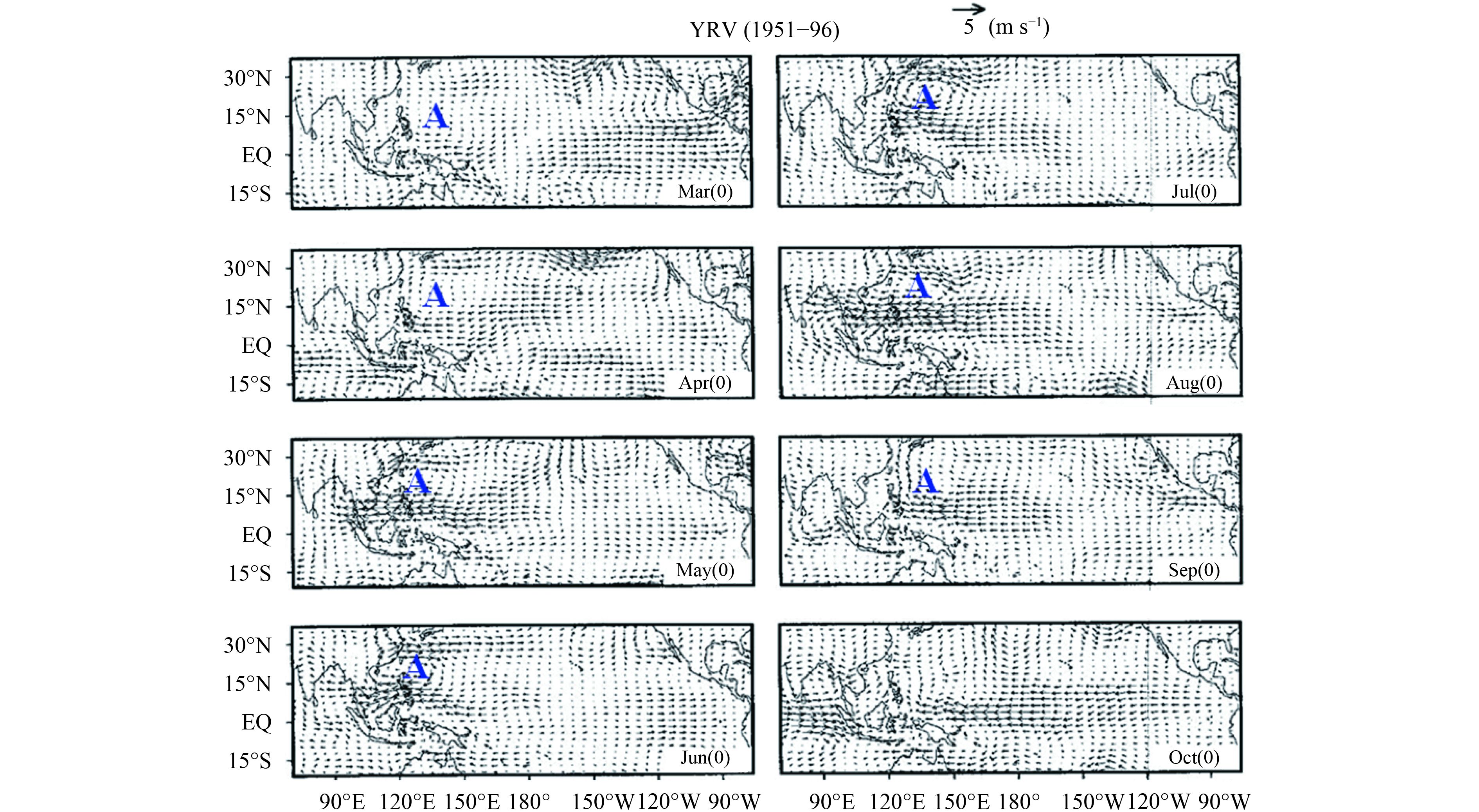
|
| Figure 2 Monthly mean anomalous 850-hPa wind fields regressed against an area-averaged rainfall index in boreal summer (May–August) over the Yangtze River Valley (YRV) basin. Station rainfall data in China and NCEP reanalysis I datasets for the period of 1951–96 were used for the regression analysis. FromChang et al. (2000a). |
As demonstrated in Section 2, an important circulation system that conveys the El Niño impact on East Asia is an anomalous low-level anticyclone over the western North Pacific (WNP). In this review paper, we will discuss how this anomalous anticyclone (named WNPAC hereafter) is formed prior to and during El Niño mature winter, how it is maintained from the mature winter to the succeeding summer, and how it affects the rainfall over East Asia in the El Niño decaying summer. Special attention will be paid to how the WNPAC was discovered, and what theories have been proposed so far to understand the formation and maintenance of the WNPAC. The key physical processes behind and the limitations of these theories will be discussed.
The remaining of this review paper is organized as follows. In Section 2, we will first describe how the WNPAC was discovered. In Section 3, we will present the various existing theories that have been proposed to understand the formation and maintenance of the WNPAC, including the warm pool atmosphere–ocean interaction theory, Indian Ocean (IO) capacitor theory, combination mode theory, moist enthalpy advection/Rossby wave modulation theory, and central Pacific SSTA forcing theory. In Section 4, we will discuss some outstanding issues such as the processes that contribute to the onset of the WNPAC and a possible role of tropical Atlantic SSTA. Finally, a conclusion is given in Section 5.
2 Role of the WNPAC in connecting ENSO to East Asian climateTwo sets of pioneer observational analyses were among the first discovering the WNPAC that links El Niño and East Asian rainfall anomalies. The first set of the work was based on the rainfall variability in China (Fu and Teng, 1988; Chang et al., 2000a). Figure 2, copied from Chang et al. (2000a), shows the horizontal pattern of anomalous wind fields at 850 hPa regressed onto the summer rainfall index over the Yangtze River Valley (YRV). Note that in June–August, a simultaneous low-level anticyclonic circulation is clearly seen in the WNP. This implies that an anomalous anticyclone appeared in the WNP when significant positive rainfall anomalies occurred in the YRV. The WNPAC signal can be traced back to the preceding spring and winter when there are pronounced low-level westerly anomalies over the equatorial eastern Pacific. Accompanying the equatorial westerlies is the El Niño-like SSTA pattern in the eastern equatorial Pacific, which can be clearly seen from the regressed SSTA pattern (figure omitted).
How does the anomalous anticyclone in the WNP strengthen the summer Meiyu/Baiu rainfall over East Asia? Chang et al. (2000a) argued that the following three processes might be responsible for enhanced Meiyu/Baiu rainfall along the Yangtze River basin. The first is northward transport of high mean moisture from the tropics by anomalous southerlies at the west edge of the WNPAC. The second is through enhanced pressure gradients between the low pressure Meiyu/Baiu frontal system and the high pressure associated with the WNPAC to its southeast. The third possible process is the slowing down of eastward propagating synoptic-scale disturbances along the front, leading to more quasi-stationary rainfall.
The second set of the observational analyses was based on the El Niño composite (Zhang et al., 1996; Wang et al., 2000). While Zhang et al. (1996) focused on two moderate El Niño events in 1986/87 and 1991/92 and demonstrated that an anomalous anticyclone appeared over the WNP in the mature phases of these two El Niños, Wang et al. (2000) composed all El Niño events since 1958. A statistically significant feature of the El Niño composite is the occurrence of an anomalous anticyclone over the Philippine Sea during El Niño mature winter, and this anomalous anticyclone persisted from northern winter to the subsequent summer (Wang et al., 2000). Wang and Zhang (2002) further showed that the onset of the WNPAC started in northern fall during the El Niño developing phase.
Applying a season-sequence Singular Vector Decomposition (SVD) analysis method, Wang et al. (2003) illustrated for the first time the seasonal evolution patterns of dominant circulation anomalies over the Indo-western Pacific domain from El Niño developing summer [JJA(0)] to its decaying summer [JJA(1)], as shown inFig. 3. Major features of the season-sequence SVD analysis are summarized below. An anticyclonic circulation anomaly occurs over the tropical IO in El Niño developing summer. This anomalous circulation may be viewed as a direct response to a negative heating anomaly over the Maritime Continent (Wang et al., 2003). Then, this anomalous anticyclone moves eastward and arrives in South China Sea (SCS) in SON(0) and in Philippine Sea in the succeeding winter. This eastward moving characteristic was illustrated in Wu et al. (2003) and Chou (2004) and its mechanism was discussed by Chen et al. (2007), who studied the impact of El Niño on SCS SSTA transition. The WNPAC is fully developed during El Niño mature winter.
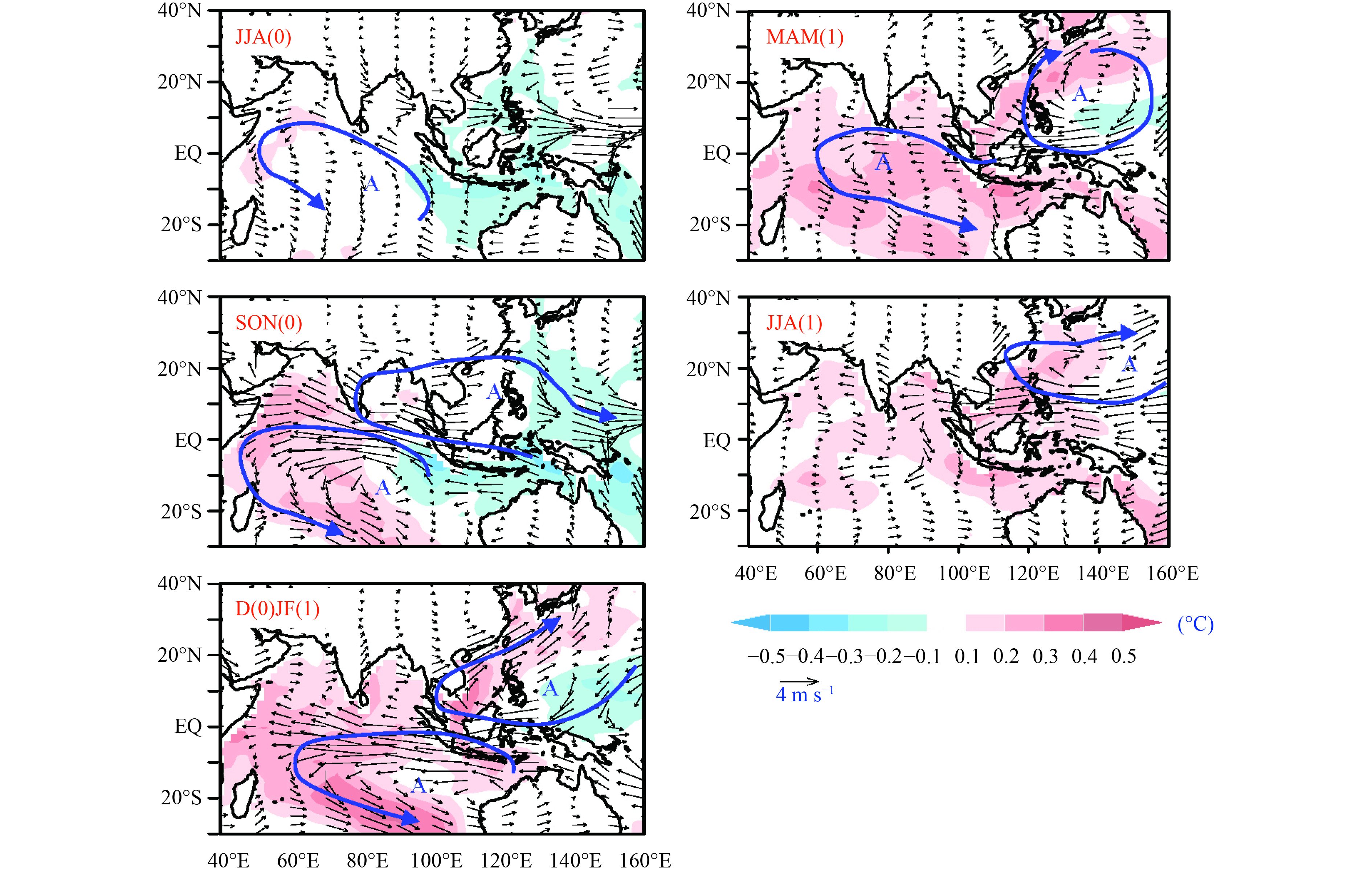
|
| Figure 3 Seasonal evolving patterns of 850-hPa wind (vector, m s–1) and SST (shading, °C) anomalies associated with El Niño turnabout from the developing summer JJA(0), to the decaying summer JJA(1) (see labels on upper left of each panel) calculated based on the SS-SVD analysis. From Wang et al. (2003). |
Accompanied with the anomalous anticyclone in El Niño mature winter is a dipole SSTA pattern with an anomalous cooling in eastern WNP and an anomalous warming in SCS and along the East Asian coast. Both the WNPAC and the SSTA dipole persist from El Niño mature winter to the succeeding summer, indicative of a possible air–sea interaction.
Over the tropical IO, a pronounced dipole SSTA pattern is clearly seen in SON(0). Associated with this SST dipole is easterly anomaly at the equator. This season-dependent feature is consistent with the fact that the peak phase of the IO dipole mode occurs in northern fall because a season-dependent coupled instability appears over southeast IO off the coast of Sumatra (Li et al., 2003). This dipole SSTA pattern quickly evolves into a basin-wide pattern in the tropical IO in northern winter, due to both the remote El Niño forcing and local ocean wave dynamics (Li et al., 2003; Hong et al., 2010). The basin-wide warming persists from El Niño mature winter to the succeeding summer.
A notable feature is the contrast of the low-level circulation anomaly in the WNP (cyclonic vs. anticyclonic flow) between El Niño developing summer and mature winter, even though the SSTA pattern in the tropical Pacific is quite similar between the two seasons. This clearly indicates the modulation of the annual cycle background state on El Niño impact. But so resulted anomalies still have a dominant interannual period, differing from a combination mode theory to be discussed in Section 3.3, which emphasizes near-annual periods.
Another interesting feature is the quasi-biennial oscillation in the WNP. A cyclonic circulation anomaly dominates the WNP during El Niño developing summer. This is the season when typhoons tend to shift their genesis locations southeastward (Wang and Chan, 2002) and the season when more frequency TC genesis occurs in the WNP (Li, 2012). In contrast, an anomalous anticyclone dominates the WNP during El Niño decaying summer. This is the typical season when significantly fewer TCs occur in the WNP (Li, 2012). Thus, through background state modulation, El Niño promotes a quasi-biennial tend-ency for the WNP summer monsoon. Such a biennial oscillation results from ENSO turnabout, and differs from the previous tropospheric biennial oscillation (TBO) theories that emphasize either the South Asian monsoon–Australian monsoon teleconnection (Meehl, 1987; Chang and Li, 2000) or the atmosphere–ocean interaction in the warm pool (Li et al., 2006).
To sum up, the modulation of the El Niño remote forcing effect by the annual cycle background mean state was clearly demonstrated in the context of the season-sequence SVD analysis (Wang et al., 2003). The WNPAC, the IO dipole mode, the IO basin mode, and the quasi-biennial oscillation are parts of the ENSO–annual cycle interaction. Specific processes through which the WNPAC forms and is maintained due to ocean–atmosphere coupling and atmospheric internal dynamics will be discussed in the next section.
3 Formation and maintenance mechanisms of the WNPACIn this section, we will describe various theories that have been proposed to understand the formation and maintenance of the WNPAC. The order of these theories is listed below following time sequence, so that readers may have a better grapping as why a new theory is developed.
3.1 Warm pool atmosphere–ocean interaction theoryZhang et al. (1996) explained the formation of the WNPAC as a Rossby wave response to a negative heating anomaly over the WNP during El Niño mature phase, but did not explain what caused the negative heating anomaly. Wang et al. (2000) proposed a local thermodynamic atmosphere–ocean interaction mechanism to explain the formation of the WNPAC. Figure 4 is a schematic diagram for this theory. In response to El Niño induced anomalous heating over the central equatorial Pacific, a Rossby wave response with low-level cyclonic gyre appears in the eastern part of the tropical WNP. Anomalous northeasterly to the west of the Rossby gyre induces a cold SSTA due to enhanced local surface evaporation, because the anomalous northeasterly coincides with the mean northeasterly. The cold SSTA may suppress local convective heating and induce an anomalous anticyclone to its west, as a Rossby wave response to the negative heating anomaly. Anomalous northeasterly to the east of the anticyclone further strengthens the cooling due to enhanced wind–evaporation/entrainment–SST feedback. As a result of the positive thermodynamic air–sea feedback, the WNPAC forms and is maintained from the winter to subsequent summer. Meanwhile, anomalous southwesterly to the west of the anticyclone induces a warming at the ocean surface due to reduced surface evaporation (as the anomalous wind is against the mean wind there) and ocean advection. This forms a dipole SST pattern in the tropical WNP.
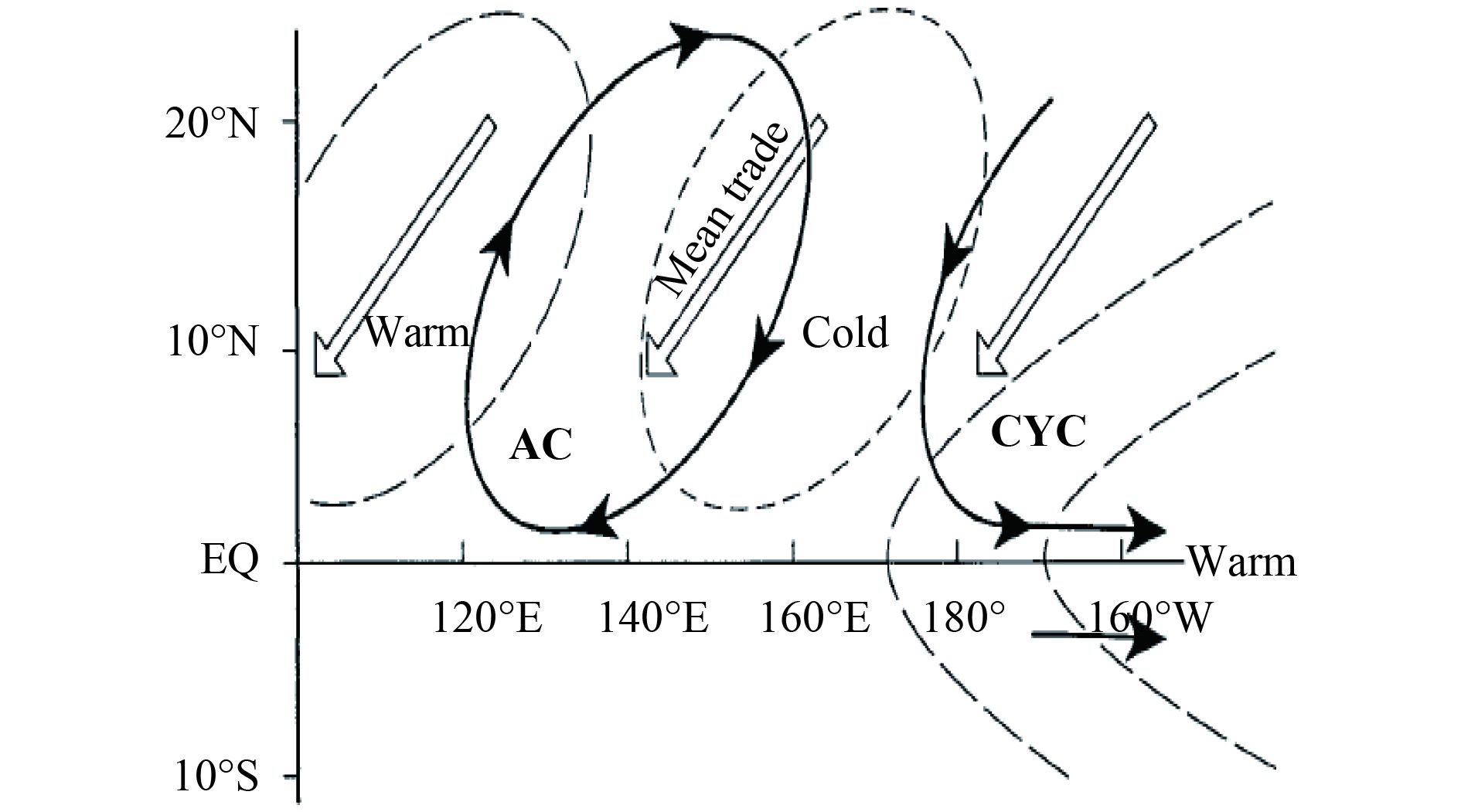
|
| Figure 4 A schematic diagram illustrating the effect of a positive air–sea feedback between the WNPAC and cold SSTA in WNP. The double arrow denotes the background mean trade wind, and heavy lines with black arrows represent the anomalous wind. The long (short) dashed lines represent a positive (negative) SSTA. From Wang et al. (2000). |
The atmosphere–ocean feedback process mentioned above can maintain the WNPAC from the El Niño mature winter to the following spring. Some argued that when summer arrives, the mean flow changes its direction in the WNP so that the air–sea feedback mentioned above becomes negative, which would dissipate the local cold SSTA during the El Niño decaying summer (Fig. 5). This argument is not necessarily true because the monsoon trough in July is tilted southeastward from northern SCS to (5°N, 160°E). As a result, only the southwest Philippine Sea is under westerlies, while most of the cooling region remains under control of easterlies. In particular, in early summer (May and June), the atmosphere–ocean interaction in the WNP remains positive and significant (Xiang et al., 2013). The decay of the amplitude of the cooling may be related to the increase of warming effect of solar radiation and the reduction of cooling effect of evaporation. As noted by Xiang et al. (2013), the majority of strong WNP subtropical high cases exhibit anomalous intensification in late summer (August), which is determined by the seasonal northward shift of mean precipitation that makes atmospheric response much more sensitive to local SST forcing than in early summer. In addition, dry advection to the east of the WNPAC plays a role in suppressing convection over the Philippine Sea (Fig. 5).
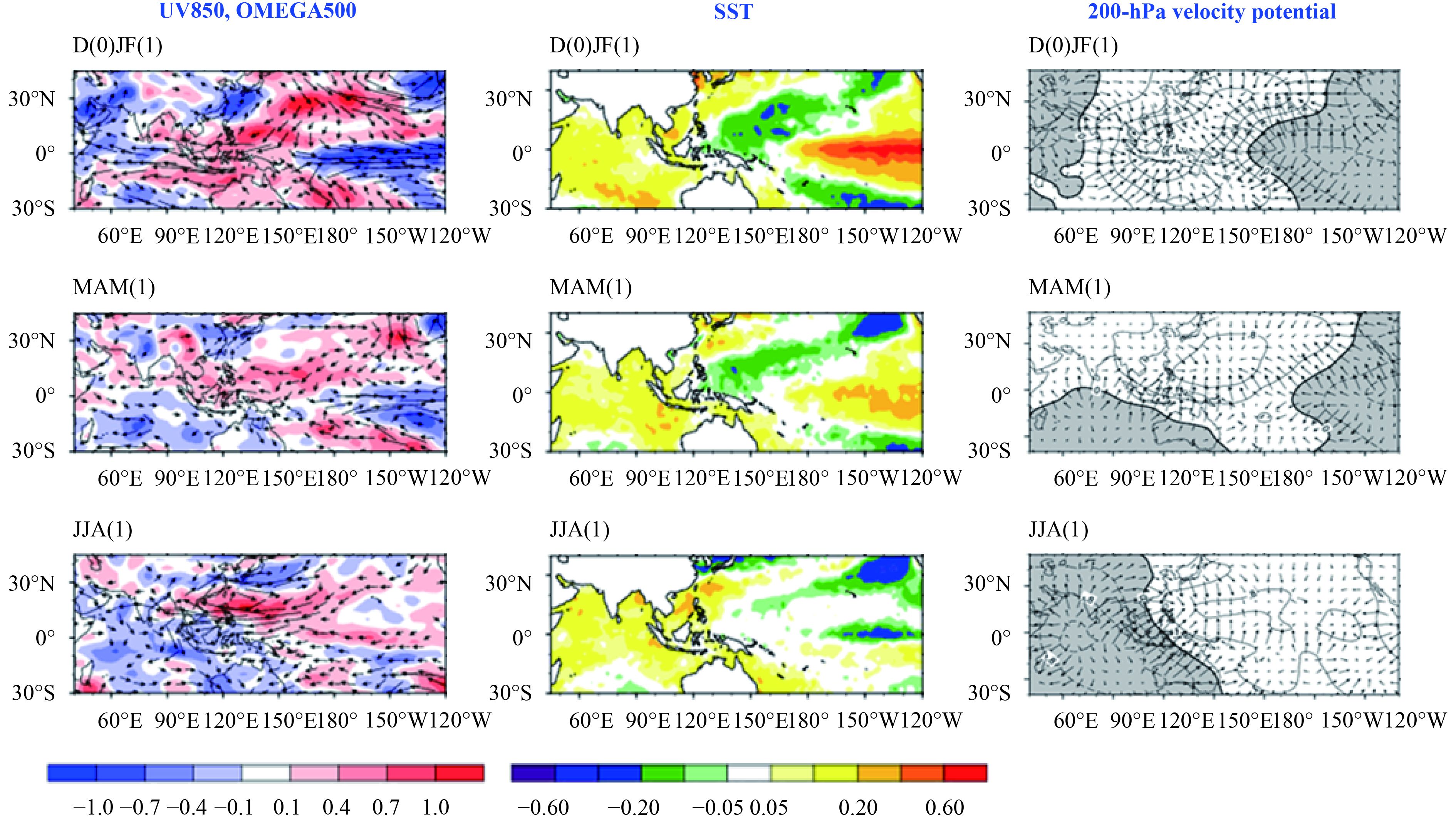
|
| Figure 5 Seasonal evolution patterns of (left) anomalous 850-hPa wind (vector, m s–1) and 500-hPa vertical p-velocity (10–2 hPa s–1), (middle) SST (°C), and (right) 200-hPa velocity potential (10–6 m2 s–1) fields derived from 12-El Niño composite from El Niño mature winter to the subsequent summer during 1950–2006. From Li and Hsu (2017). |
While the local atmosphere–ocean interaction theory by Wang et al. (2000) focused on the WNP, Wang et al. (2013) further extended this theory by considering atmosphere–ocean interaction across the Indo-Pacific warm pool as a whole. Their EOF analysis of summer mean 850-hPa geopotential height (H850) field for the period of 1979–2009 showed that the leading EOF mode accounts for 31% of the total H850 variance. The horizon-tal pattern of this mode is characterized by an intense southwest–northeast oriented WNPAC, which concurs with suppressed rainfall on its southeastern flank and enhanced rainfall in Korea, Japan, and eastern central China (Fig. 6).
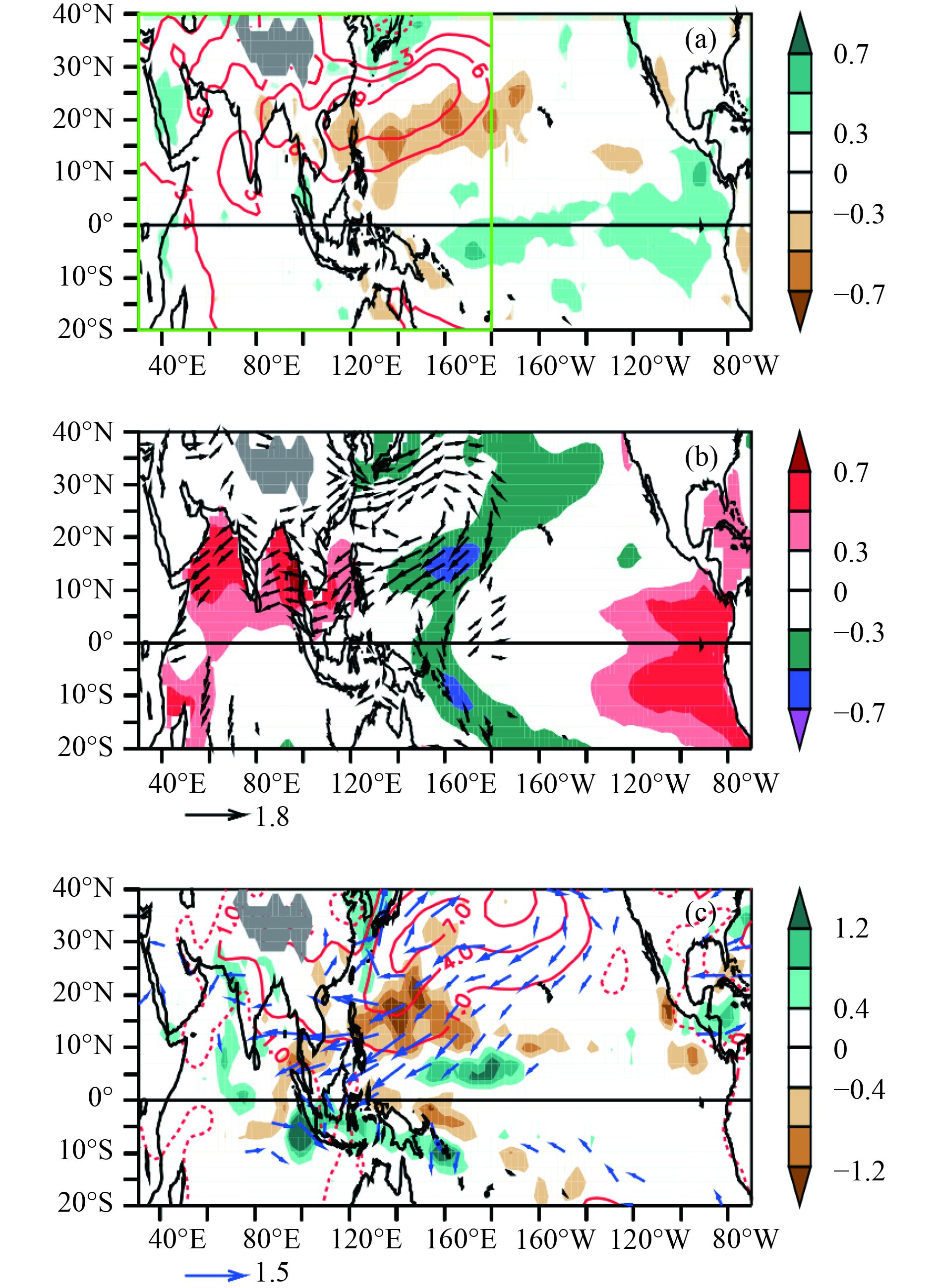
|
| Figure 6 The first EOF mode derived from summer (JJA) mean 850-hPa geopotential height (H850) in the Asian–Australian monsoon domain (20°S–40°N, 30°E–180°) for 1979–2009. (a) Spatial pattern (contour) and the correlated precipitation (shading) in the Indo-Pacific domain with correlations significant at 90% confidence (r > 0.3). (b) The correlated SSTA (shading) and 850-hPa wind anomalies with reference to the principal component of EOF-1. (c) Simulated JJA mean H850 (contour, m), precipitation (shading, mm day –1), H850 (contours, m), and 1000-hPa wind anomaly (m s–1) in response to an initial SST perturbation over the WNP in a coupled model experiment. Adopted from Wang et al. (2013). |
Wang et al. (2013) argued that a positive feedback between the WNPAC and underlying dipolar SST anomalies over the WNP and tropical IO plays a central role in maintaining this pattern. First, to the southeast of the WNPAC, the SST is cooler because the anomalous northeasterly winds strengthen mean easterlies to the east of the monsoon trough, thereby enhancing evaporation/ entrainment. Conversely, the resultant ocean cooling would, in turn, reduce in situ precipitation heating (Figs. 6a, b), hence generating descending Rossby waves that reinforce the WNPAC in their westward decaying journey (Wang et al., 2000). Numerical experiments with a coupled model demonstrate that an initial SST cooling in the WNP in May can indeed induce and maintain an anomalous WNPAC in the ensuing summer (Fig. 6c). The out-of-phase relation between rainfall anomalies over India and WNP inferred from the coupled simulation is consistent with the observed South Asia–WNP monsoon relationship (Gu et al., 2010).
Secondly, to the southwest of the enhanced WNPAC, the SCS and northern IO warm because the easterly anomalies associated with the WNPAC weaken the south-west monsoons (Fig. 6b), thereby reducing surface latent heat flux. Conversely, the northern IO warming would help sustain the WNPAC (Wu et al., 2009, 2010a; Xie et al., 2009). Thus, the interplay between the WNPAC and this dipolar SSTA pattern contributes to the maintenance of the WNPAC.
To sum up, the analysis of summer 850-hPa geopotential height field reveals a self-sustained interbasin coupled atmosphere–ocean mode across the tropical IO and WNP. Under this new framework, the IO warming is not viewed as an external forcing to the WNPAC, rather a part of the interbasin coupled mode. This emerging new theory supports the notion that summer monsoon and underlying warm oceans are highly interactive (Wang et al., 2005). Figure 7 is a schematic diagram summarizing the main processes associated with this interbasin coupled mode. It extends the original local air–sea interaction theory of Wang et al. (2000) by including interbasin atmosphere–ocean interaction across the tropical IO and WNP.
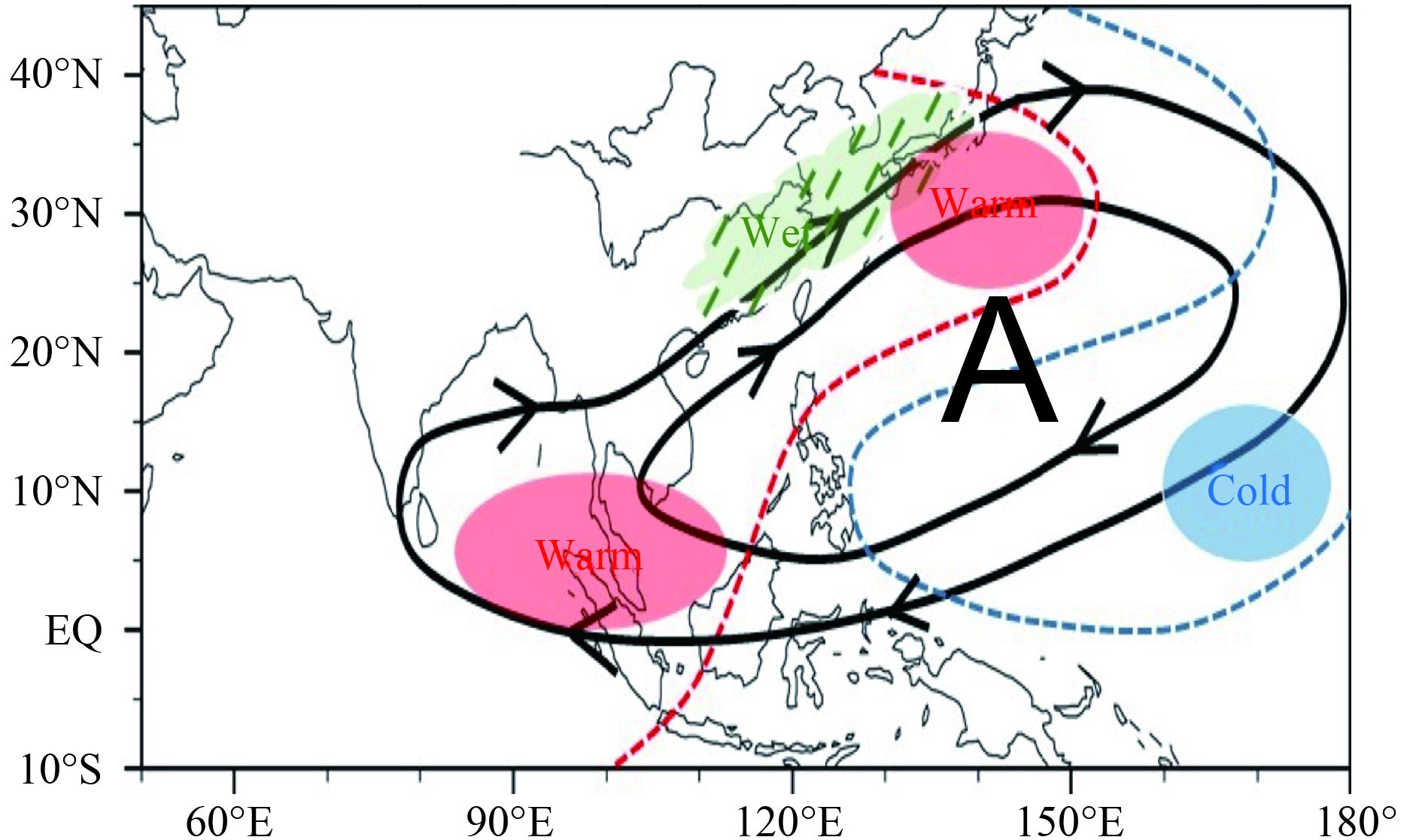
|
| Figure 7 Schematic diagrams showing the interaction between the WNPAC and Indo-Pacific SST dipole. The figure is drawn based on the composite anomalies associated with 8 strong El Niño events during 1957–2016. “A” in black indicates the anticyclonic circulation. Adopted fromWang et al. (2017). |
Observed SST evolution patterns in Fig. 5 show that the IO basin-wide warming persists from the El Niño mature winter to the succeeding summer. Does this basin-wide warming exert a remote impact on WNP circulation? Early observational analyses showed significant correlations between the IO basin-wide warming and western Pacific geopotential height/summer Yangtze River rainfall anomalies (e.g., Hu, 1997; Gong and Ho, 2002). The connection of western Pacific circulation with the IO basin warming has been demonstrated by numerical model experiments (e.g., Lau and Nath, 2003; Lau and Wang, 2006; Lau et al., 2006; Yang et al., 2007; Li et al., 2008; Zhou et al., 2009b). Studying the remote effect of the IO basin mode leads to the discovery of the second theory for the WNPAC, namely, the IO capacitor effect (Wu et al., 2009; Xie et al., 2009).
One important issue regarding the IO SSTA effect is whether or not the IO basin warming can induce an anomalous anticyclone in the WNP during El Niño mature winter. Previous atmospheric modeling studies with specified IO SSTA (e.g., Watanabe and Jin, 2002) suggested that the IO basin warming in boreal winter would contribute to the formation of the WNPAC, but these studies have serious flaws and are physically incorrect.
Let us carefully examine the seasonal evolution patterns of composite vertical velocity field in the middle troposphere and upper-level velocity potential field from El Niño mature winter to the succeeding summer. Note that in the El Niño peak winter, the SSTA in the tropical IO is approximately uniform, but the vertical velocity anomaly and the upper-level velocity potential anomaly show a clear zonal dipole pattern, with anomalous ascending (descending) motion in the western (eastern) IO (Fig. 5). Thus, the warm SSTA in the western IO plays an active role in driving the atmosphere, while the warm SSTA in the eastern IO plays a passive role and is influenced by the atmosphere [i.e., the SSTA warming in the eastern IO is a result of the atmospheric forcing, due to reduced clouds and thus increased downward shortwave radiation (Klein et al., 1999)].
To further demonstrate the distinctive SSTA impacts, Chen M.-C. et al. (2016) conducted two sensitivity experiments. In the first sensitivity experiment, an atmospheric general circulation model (ECHAM4; Roeckner et al., 1996) was forced by the observed SSTA field over the tropical IO (Fig. 8a). In this case, an anomalous anticyclone in the WNP with pronounced easterly anomalies at the equator was simulated (Fig. 8b). However, the model simulated a basin-wide anomalous heating field, which does not agree with the observed rainfall pattern (Fig. 8c). In the second sensitivity experiment, the anomalous heating field shown in Fig. 8c is specified as a forcing in the model. Under this forcing scenario, the mo-del simulates an anomalous cyclone in the WNP and pronounced westerly anomalies at the equator. The numeri-cal model results indicate that a proper modeling strategy is needed in order to realistically reflect the SSTA forcing effect.
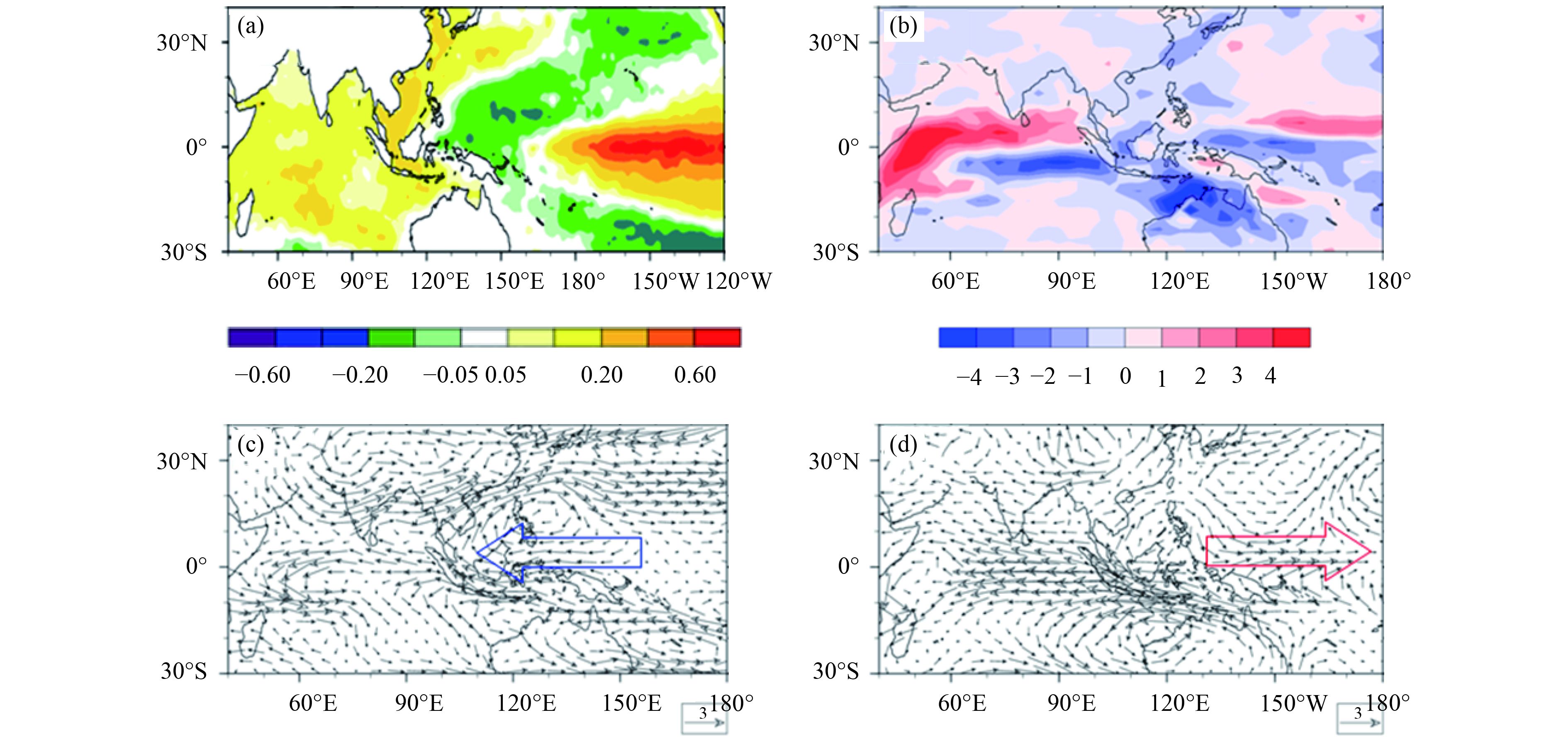
|
| Figure 8 (a, b) Composite SSTA (left, °C) and precipitation anomaly (right, mm day–1) fields during El Niño mature phase (DJF). The composite is based on 1980–2013. (c, d) Simulated 850-hPa wind anomaly fields (vectors, m s–1) from ECHAM4 in response to a specified SSTA and a diabatic heating anomaly forcing in tropical Indian Ocean as shown in (a, b). The blue (red) vector denotes anomalous easterly (westerly) wind response. From Chen M.-C. et al. (2016). |
While the rainfall pattern in the IO during El Niño mature winter is characterized by an east–west dipole, it becomes a north–south dipole in the subsequent spring, with a positive (negative) rainfall anomaly south (north) of the equator (Wu et al., 2008). Such a dipolar rainfall pattern is expected to have a minor impact on the WNP circulation.
The IO basin-wide warming becomes most effective in affecting the WNPAC only during the El Niño decaying summer, when a basin-wide ascending motion anomaly and a basin-wide rainfall anomaly appear over the tro-pical IO. Such a season-dependent IO SSTA forcing effect was first pointed out by Wu et al. (2009).
The processes through which the tropical IO basin SSTA affects the WNP circulation in summer are summarized in a schematic diagram in Fig. 9. In response to the basin-wide anomalous heating, anomalous easterlies associated with Kelvin wave response appear to the east of the heat source. The Kelvin wave easterlies have a maximum at the equator and decrease with latitudes. This generates anticyclonic shear at both sides of the equator, leading to boundary layer divergence off the equator. The descending motion anomaly at top of the PBL associated with the Ekman pumping divergence leads to the decrease of local specific humidity, which further suppresses the mean convection in the monsoon trough region. The so generated negative diabatic heating anomaly further induces an anomalous anticyclone at low level, maintaining the WNPAC (Wu et al., 2009).
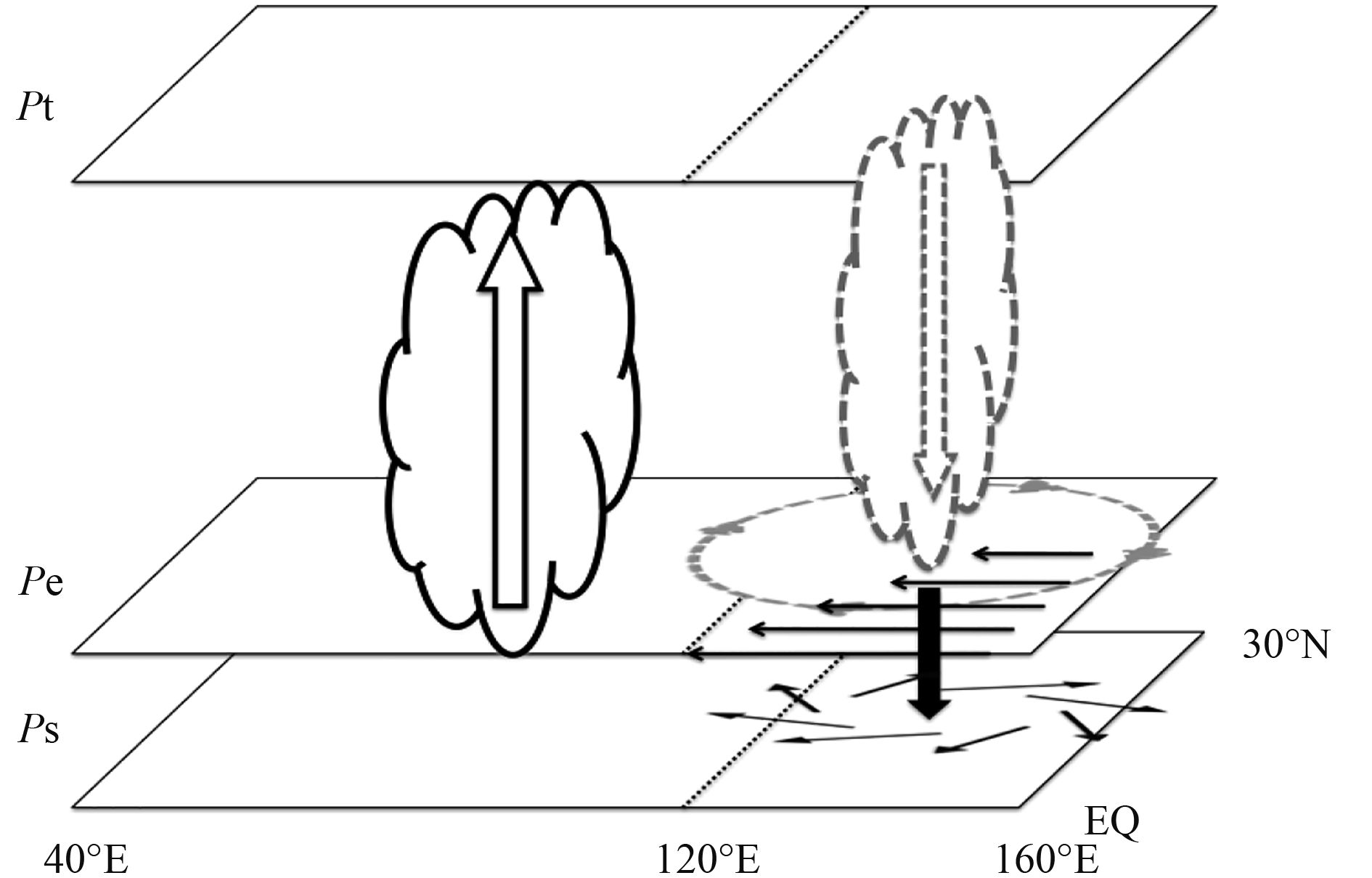
|
| Figure 9 Schematic diagram illustrating the impact of Indian Ocean basin-wide heating on WNP anomalous anticyclone during El Niño decaying summer. From Wu et al. (2009). |
Does the local cold SSTA in the WNP play a role in maintaining the anomalous anticyclone during El Niño decaying summer? Through a number of idealized numerical experiments, Wu et al. (2010a) demonstrated that both the local cold SSTA in the WNP and the remote SSTA forcing from the tropical IO are important in maintaining the WNPAC throughout the El Niño decaying summer. Figure 10 shows the same model simulation results as in Wu et al. (2010a) but with a slightly larger western Pacific domain (see Fig. 10a). The results indicated that on seasonal average, both the local SSTA in the WNP and the remote SSTA in the tropical IO are equally important in sustaining the WNPAC throughout the summer (Fig. 10b). As expected, the local SSTA effect becomes weaker as the summer progresses. However, the remote effect becomes stronger, even though the IO SSTA decreases slightly with time.

|
| Figure 10 (a) Geographic domains for the tropical Indian Ocean and western Pacific, where the SST anomalies are specified as the model lower boundary condition for the western Pacific (WP) and Indian Ocean (IND) runs. (b) Temporal evolutions of area-averaged vorticity anomalies (10–6 m2 s–1) over the region of 10°–35°N, 110°–160°E for the WP (dashed line) and IND (solid line) SSTA forcing runs. |
Physical argument behind the modeling result is discussed in the following. A significant cold SSTA appears in the WNP prior to the summer monsoon onset. This cold SSTA could have a negative impact on the monsoon convection, even though negative air–sea feedback in summer may dissipate the cold SSTA. From monthly SSTA evolution, one can see clearly that the cold SSTA in the WNP decreases gradually, and the cold SSTA signal is clearly seen in June and even in July. The enhanced IO forcing effect with time is attributed to the modulation of the mean state. The anticyclonic shear effect associated with the Kelvin wave response can only be fully realized when the WNP monsoon trough reaches a peak phase in late summer (see Wu et al., 2010a for detailed discussion on this mechanism).
To sum up, the IO basin-wide warming does not contribute to the formation and maintenance of the WNPAC during El Niño mature winter and spring, but it does play a role in maintaining the WNPAC during El Niño decaying summer. The remote IO forcing effect is as important as the local SSTA in the WNP during El Niño decaying summer.
3.3 Combination mode theoryStuecker et al. (2015) proposed a “combination mode” (C-mode) theory in an attempt to explain the formation and maintenance of the WNPAC during El Niño. The essence of this theory lies in the nonlinear interference between the annual cycle and ENSO frequencies. From a pure mathematical point of view, the product of two time series with an annual and an interannual period would lead to two “near-annual” periods, roughly 0.8- and 1.2-yr periods.
As discussed in Section 3.1, the modulation of the ENSO impact by the annual cycle background state has been clearly demonstrated in the season-sequence SVD analysis (Wang et al., 2003). But so-resulting atmospheric anomalies still have a dominant interannual period. A key question related to feasibility of the mathematically derived C-mode is whether or not the near-annual periods are observed in the real observational data. In a comment paper, Li et al. (2016) addressed this issue. Six representative regions across the tropical Indo-Pacific domain were selected for validation. By conducting the power spectrum analysis of observed surface and low-level circulation anomaly fields in each of the six regions, Li et al. (2016) noted that the 0.8- and 1.2-yr periods are not detectable from these observational data (Fig. 11). In contrast, the most dominant periods are still on the interannual timescale. In other words, the near-annual periods predicted by the C-mode theory are hardly detected from the observational data, and their power spectrums appear statistically insignificant.
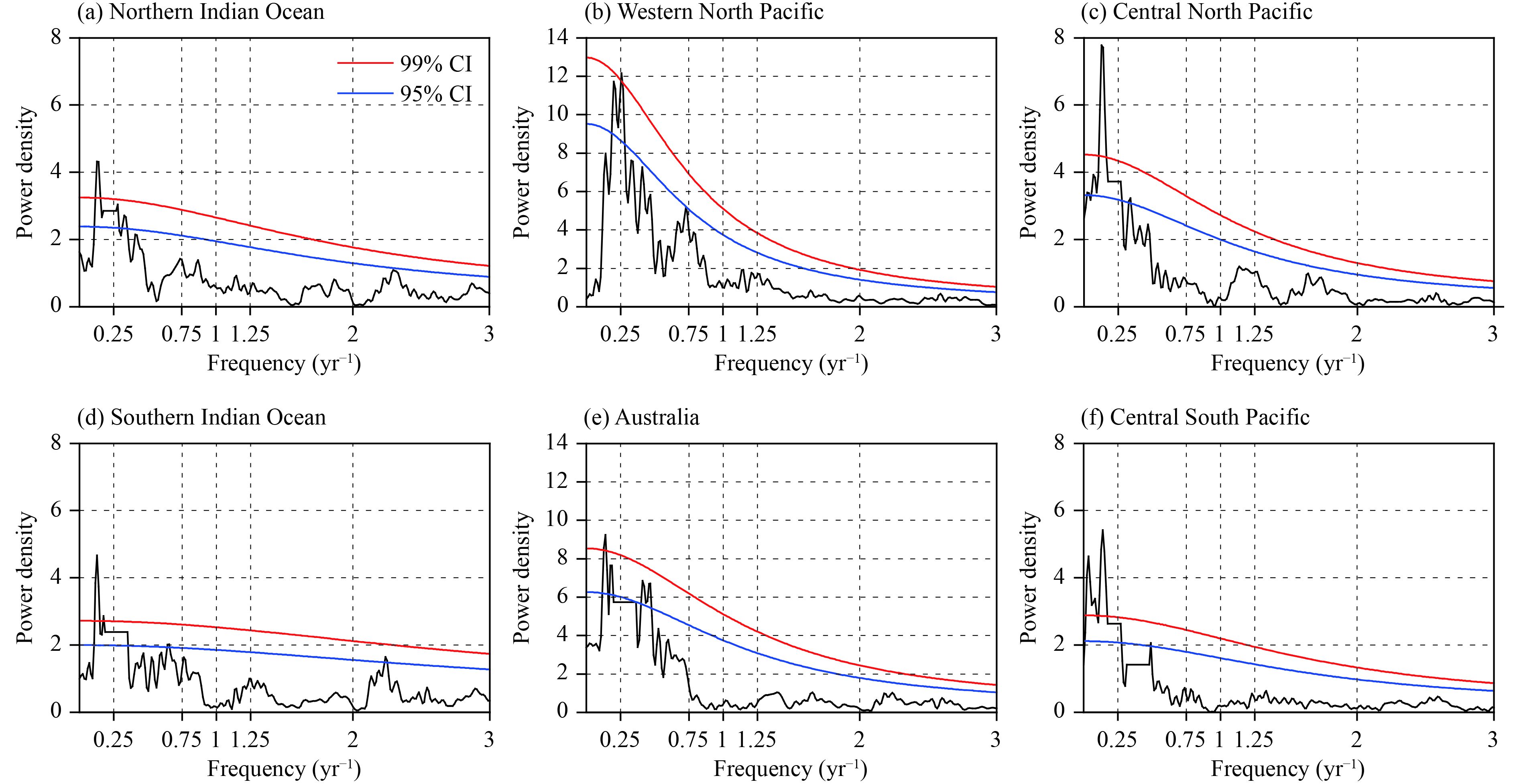
|
| Figure 11 Power spectra for sea level pressure (SLP) anomalies averaged in (a) northern Indian Ocean (5°–20°N, 60°–100°E), (b) western North Pacific (5°–20°N, 120°–160°E), (c) central North Pacific (5°–20°N, 180°–140°W), (d) southern Indian Ocean (20°–5°S, 60°–100°E), (e) Australia (20°–5°S, 120°–160°E), and (f) central South Pacific (20°–5°S, 180°–140°W). Black lines indicate the power density and colored lines indicate the respective confidence interval (CI) based on a red noise null hypothesis. From Li et al. (2016). |
Figure 12 compares the amplitudes of sea-level pressure and 850-hPa wind anomalies associated with the interannual period (19–84 months) and a near-annual mode (with 13–19-month period) during 1997 El Niño development. Obviously, the interannual anomaly dominates over the entire Indo-Pacific sector. The amplitude of the 13–19-month mode is much weaker and can be neglected.
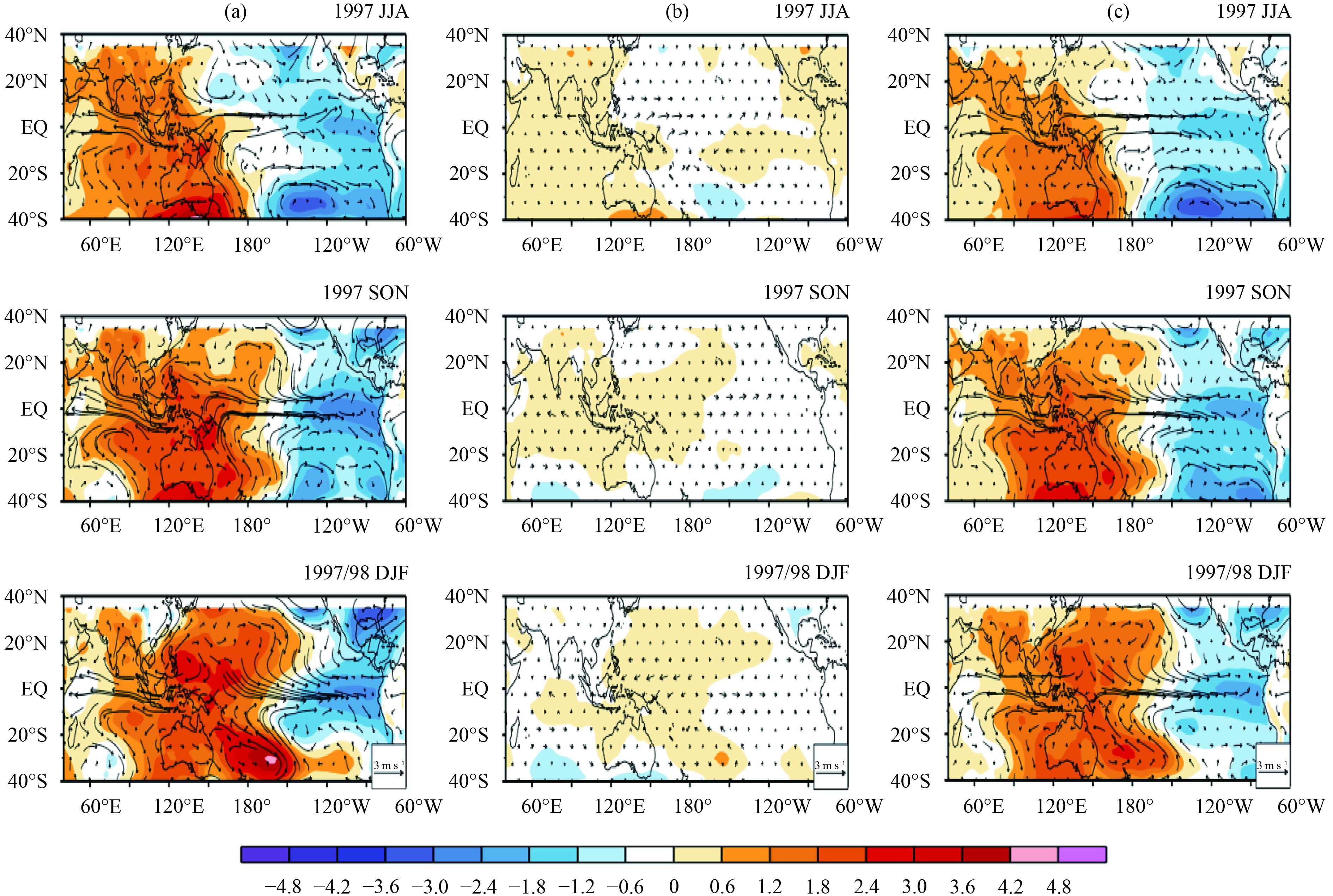
|
| Figure 12 (a) Seasonal evolution of SLP (shading, hPa) and 850-hPa wind (vectors, m s–1) anomaly fields from boreal summer to winter in 1997. The anomaly fields were derived by subtracting a climatological annual cycle and then applying a 12-month low-pass filter. (b) Same as (a) but for 13–19-month band-pass filtered anomalies. (c) Same as (a) but for 19–84-month band-pass filtered anomalies. The Butterworth filter was applied in the above calculations. From Li et al. (2016). |
A key limitation of the mathematically derived C-mode theory is lack of physical explanation of how the El Niño can remotely generate the WNPAC. In the next section, we will introduce a newly developed internal atmospheric dynamics mechanism to understand this remote forcing process.
3.4 Moist enthalpy advection/Rossby wave modulation theoryBy conducting a set of idealized, partially coupled numerical model experiments, Wu et al. (2017a, b) demonstrated that both the local air–sea interaction in the WNP and the remote El Niño forcing from the eastern equa-torial Pacific contribute to the formation of the WNPAC during El Niño mature winter. The two effects are approximately equal.
An important issue that needs to be resolved is why the atmospheric response to El Niño differs between El Niño developing summer and mature winter, even though the SSTA patterns look similar (Fig. 13). To address this issue, Wu et al. (2017a, b) conducted a diagnosis of vertical integrated moisture and moist static energy (MSE) (Neelin and Held, 1987) budgets with observational data.
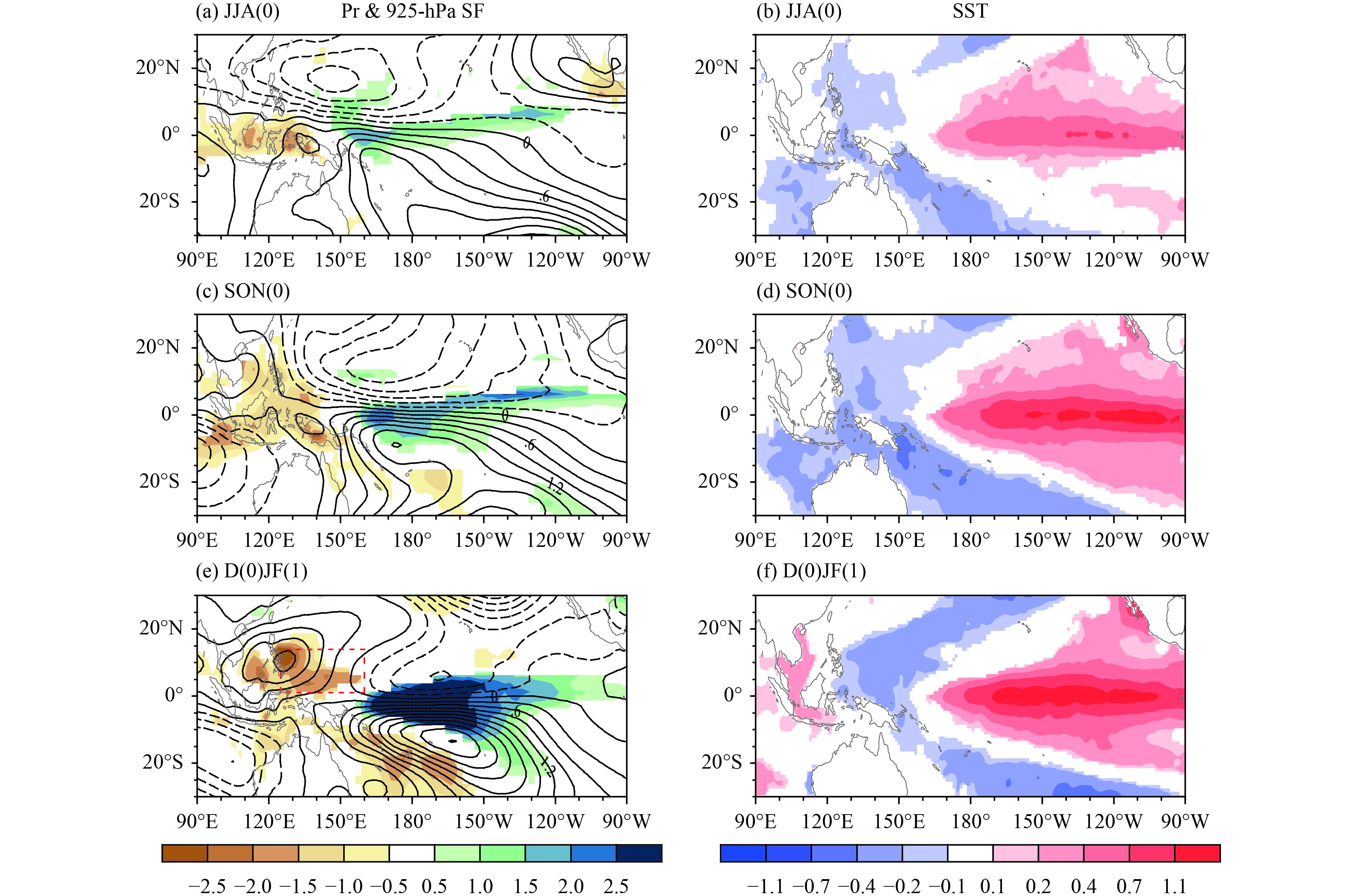
|
| Figure 13 (a, c, e) Seasonal mean precipitation (shading, mm day–1) and 925-hPa stream function anomalies (contours, 0.3×106 m2 s–1) regressed against the D(0)JF(1)-mean Niño 3.4 index for JJA(0), SON(0), and D(0)JF(1), respectively. (b, d, f) Same as the left panels but for SST anomalies (K). For the precipitation and SST anomalies, only values reaching the 5% significance level are shown. The red box in (e) (1°–14°N, 125°–160°E) denotes the key negative precipitation anomaly center for driving the WNPAC during the El Niño mature winter. From Wu et al. (2017a). |
The moisture and MSE budget analyses revealed that the negative precipitation anomaly in the WNP, which is responsible for the formation of the WNPAC, results from the advection of low mean moist enthalpy (defined as cpT + Lvq ) by anomalous low-level northerly, which is induced by El Niño heating in the central equatorial Pacific. A further diagnosis shows that the moist enthalpy advection is primarily controlled by the moisture component.
Figure 14 illustrates schematically this moist enthalpy advection mechanism. In response to El Niño induced heating anomaly in central equatorial Pacific (green filled circular area), an anomalous cyclonic gyre is formed north of the equator, as a Rossby wave response (Gill, 1980). In northern winter, maximum mean specific humidity/moist enthalpy appears near the equator and decreases toward the north. Anomalous northerly to the west of the Rossby gyre would advect low background moist enthalpy southward, leading to anomalous subsidence and thus a negative heating anomaly over the WNP (orange filled area). The negative heating anomaly in the WNP further induces an anomalous anticyclone at low level as a Rossby wave response to the anomalous heat source. As a result, the WNPAC forms.
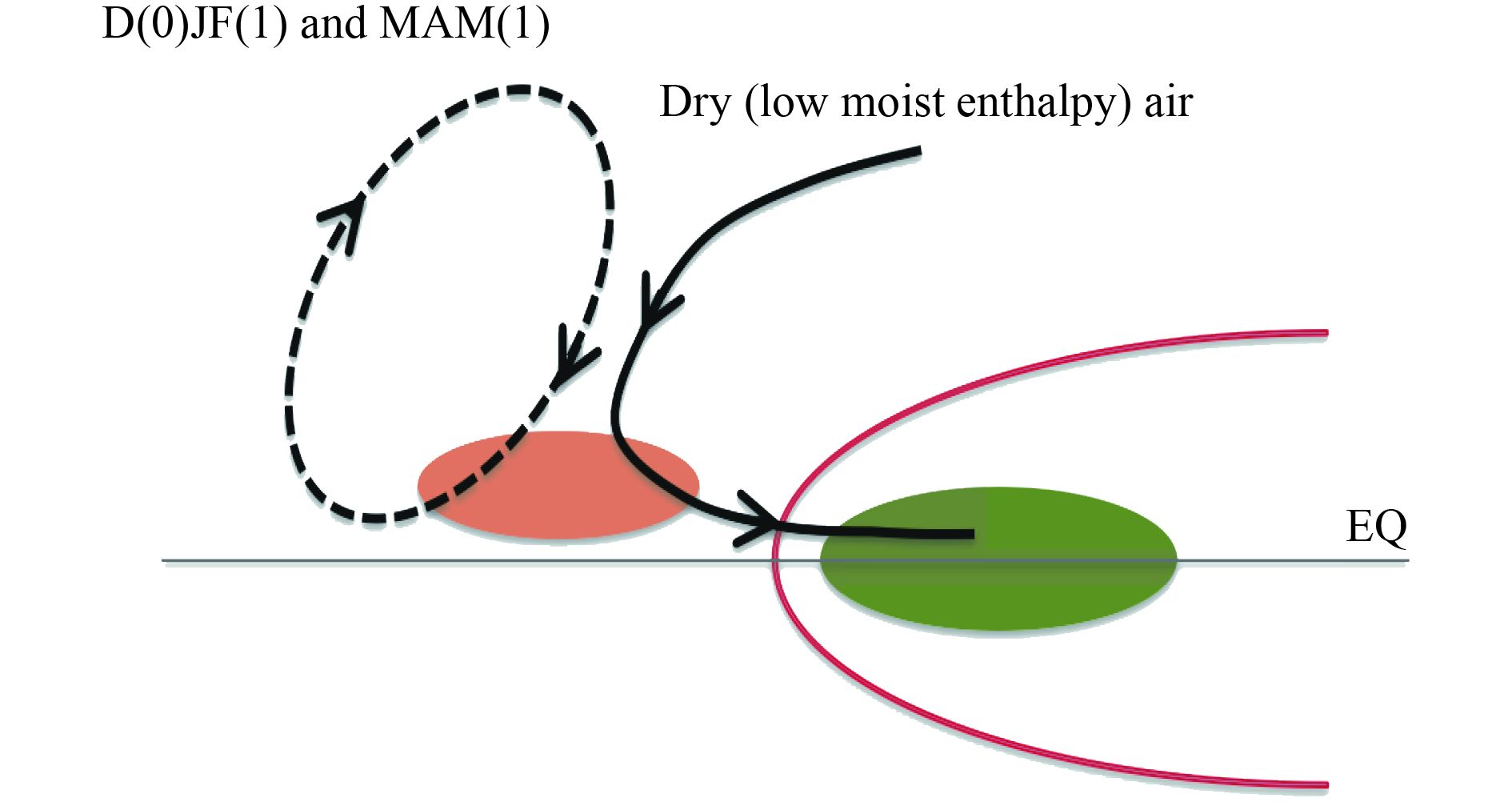
|
| Figure 14 Schematic of the moist enthalpy advection mechanism responsible for the formation and maintenance of the WNPAC during the El Niño mature winter and the following spring. Warm SSTAs in the central–eastern equatorial Pacific (red line) enhance local convection (green shading), and thus stimulate cyclonic anomalies to the northwest (black solid line). The northerly anomalies at western flank of the cyclonic anomalies advect dry (low moist enthalpy) air into the tropical WNP and thus suppress convection there (orange shading). The suppressed convection further stimulates the WNPAC (black dashed line) to the northwest. From Wu et al. (2017a). |
The same low-level northerly anomaly in boreal summer, however, advects an opposite background specific humidity/moist enthalpy gradient field due to the seaso-nal change of the background mean state. Figure 15 shows the distribution of climatological monthly mean moisture field at 925 hPa from August to December. Note that a maximum mean specific humidity center appears around 20°N in August, when the monsoon trough is located over the northern most position. As time progresses, this maximum specific humidity center gradually shifts southward, and approaches the equator in December. The averaged value of meridional gradient of the mean moisture field over the WNP box region in each month is shown in the upright corner of each panel in Fig. 15. As one can see, the meridional gradient reverses its sign in November. This implies that prior to November, El Niño induced northerly anomaly causes a positive moist enthalpy advection and thus induces a positive precipitation anomaly and a low-level cyclonic circulation anomaly; whereas after November, it induces a negative moist enthalpy advection and thus a low-level anticyclonic circulation anomaly in the WNP.

|
| Figure 15 Climatological monthly mean 925-hPa specific humidity (shading, g kg–1) and anomalous wind in (a) August(0), (b) September(0), (c) October(0), (d) November(0), and (e) December(0), obtained by regression against the D(0)JF(1)-mean Niño 3.4 index (vectors, m s–1). The area-averaged meridional gradient of 925-hPa climatological specific humidity (g kg–1 m–1) over 1°–14°N, 125°–160°E is given on the top right corner of each panel. From Wu et al. (2017b). |
In addition to the mean moisture gradient change, the annual cycle of background vorticity field also modulates the beta effect, which is essential in determining the strength of Rossby wave response. It is interesting to note that the zonal extent of the low-level cyclonic flow anomaly during El Niño developing summer is much greater than that of the cyclonic anomaly during El Niño mature winter (Fig. 13). Because of the eastward retreat in northern winter, the anomalous anticyclone has space to develop in the WNP. Wu et al. (2017b) argued that the eastward retreat of the Rossby wave response in the winter is a result of the “effective” beta effect modulated by the background annual cycle state. The effective beta parameter (β*) may be expressed as
| (1) |
where β is the meridional gradient of the Coriolis parameter and
Figure 16 shows the climatological monthly mean relative vorticity distributions from August to December. Note that maximum relative vorticity center appears over the northern part of the box in August, similar to the mean specific humidity distribution. This maximum vorticity center shifts southward and moves close to the equator in December. As a result, the background relative vorticity gradient changes its sign from northern summer to winter in the key precipitation anomaly region.

|
| Figure 16 Climatological 850-hPa relative vorticity (10–6 s–1) in (a–e) August–December derived from the ECMWF interim reanalysis (ERA-Interim) dataset. The box area-averaged meridional gradient of relative vorticity (m–1 s–1) over 5°–20°N, 120°–160°E (black box) is given on the top right corner of each panel. From Wu et al. (2017b). |
Why is the season-dependent effective beta effect important? The moist enthalpy advection mechanism requires Rossby wave induced wind response, which is determined by the value of effective beta. If it is zero, there is no Rossby wave response. If it is small, the size and intensity of the Rossby wave gyre response would be small. To demonstrate this effect, we rely on an anomaly AGCM (for details, see Wang et al., 2003; Jiang and Li, 2005; Li, 2006). Observed climatological monthly mean state from August to December is specified, respectively, as the model background mean state, and the same anomalous heating is specified in the central equatorial Pacific, to mimic the El Niño forcing. Figure 17 shows the low-level steam function anomaly responses to the specified heating. Note that a much weaker response of a low-level negative stream function anomaly (or cyclonic circulation) appears in December than in August.
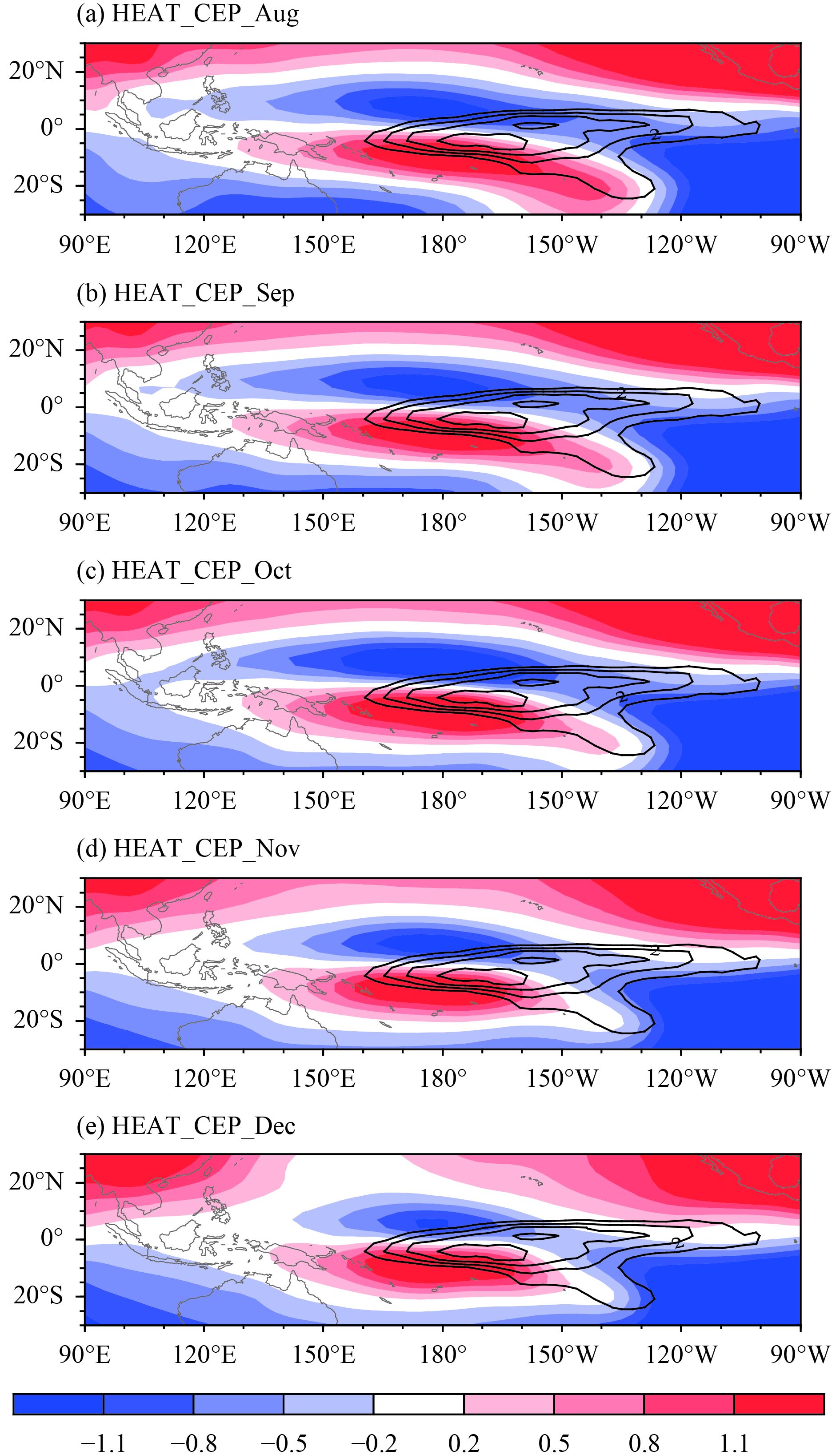
|
| Figure 17 850-hPa stream function anomalies (shading, 106 m2 s–1) simulated by an anomaly AGCM with specified background mean state (a–e) from August to December. Contours are the horizontal distributions of an anomalous heating field used to drive the dry anomaly AGCM (contour: 1 K day–1). From Wu et al. (2017b). |
A smaller cyclonic cell at low level implies an eastward shift of northerly anomalies and thus an eastward shift of negative precipitation anomaly, which would leave space for the anomalous anticyclone to develop in the WNP. Thus, the combined moist enthalpy advection and Rossby wave modulation process holds a key for explaining the distinctive summer–winter contrast of the WNP circulation from El Niño developing summer to its mature winter.Figure 18 shows schematically how this combined mechanism works in the presence of seasonal change of the background moisture and vorticity fields.
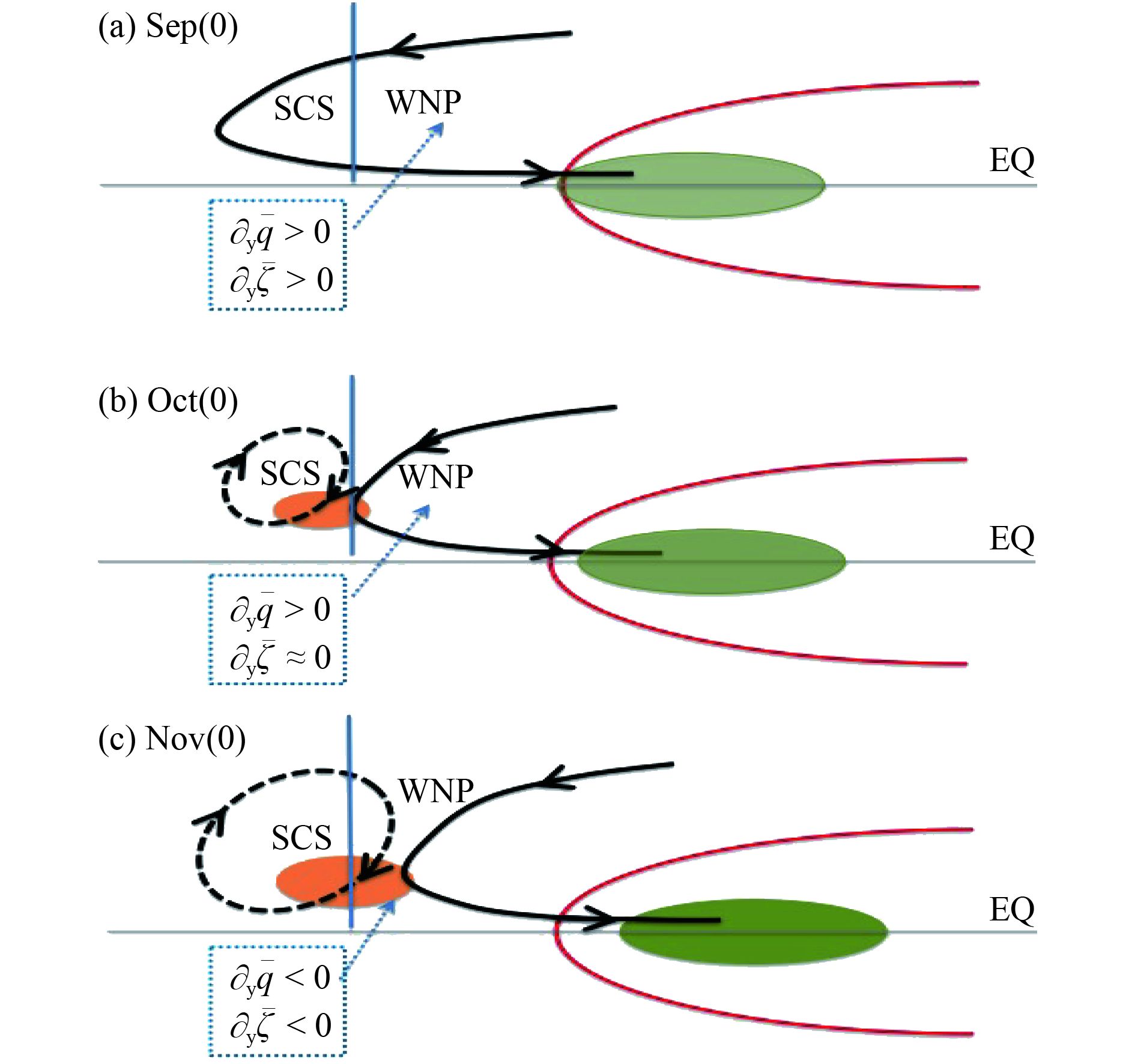
|
|
Figure 18 Schematic of the combined moist enthalpy advection/Rossby wave modulation mechanism. During the El Niño developing phase [Sep(0)], westward stretch of the cyclonic anomalies is enhanced by the positive meridional gradient of the mean relative vorticity (
|
The aforementioned theories primarily focus on processes during the El Niño mature and decaying phases. A direct EOF analysis of the geopotential height anomaly field in boreal summer revealed that an anomalous anticyclone might occur without the concurrence of a decaying El Niño or IO warming (Wang et al., 2013; Xiang et al., 2013). Thus, it is necessary to reshape the conventional thinking on the cause of the WNPAC in boreal summer, beyond the El Niño decaying dynamics.
The leading EOF mode of the summer mean H850 field has been discussed in Section 3.1. Here, we will focus on the discussion of the second mode. The second EOF mode accounts for 22.2% of the total H850 variance. It features a strong anomalous WNPAC and a weak IO low (Fig. 19a). The anomalous WNPAC ridge and the associated suppressed convection extend from the Philippine Sea southeastward to the equatorial western Pacific. The enhanced WNPAC concurs with equatorial central Pacific cooling (Fig. 19b); the corresponding principal component is negatively correlated with the Niño 3.4 index (r = –0.68), suggesting that the WNPAC in this mode reflects a developing or a persisting La Niña event.
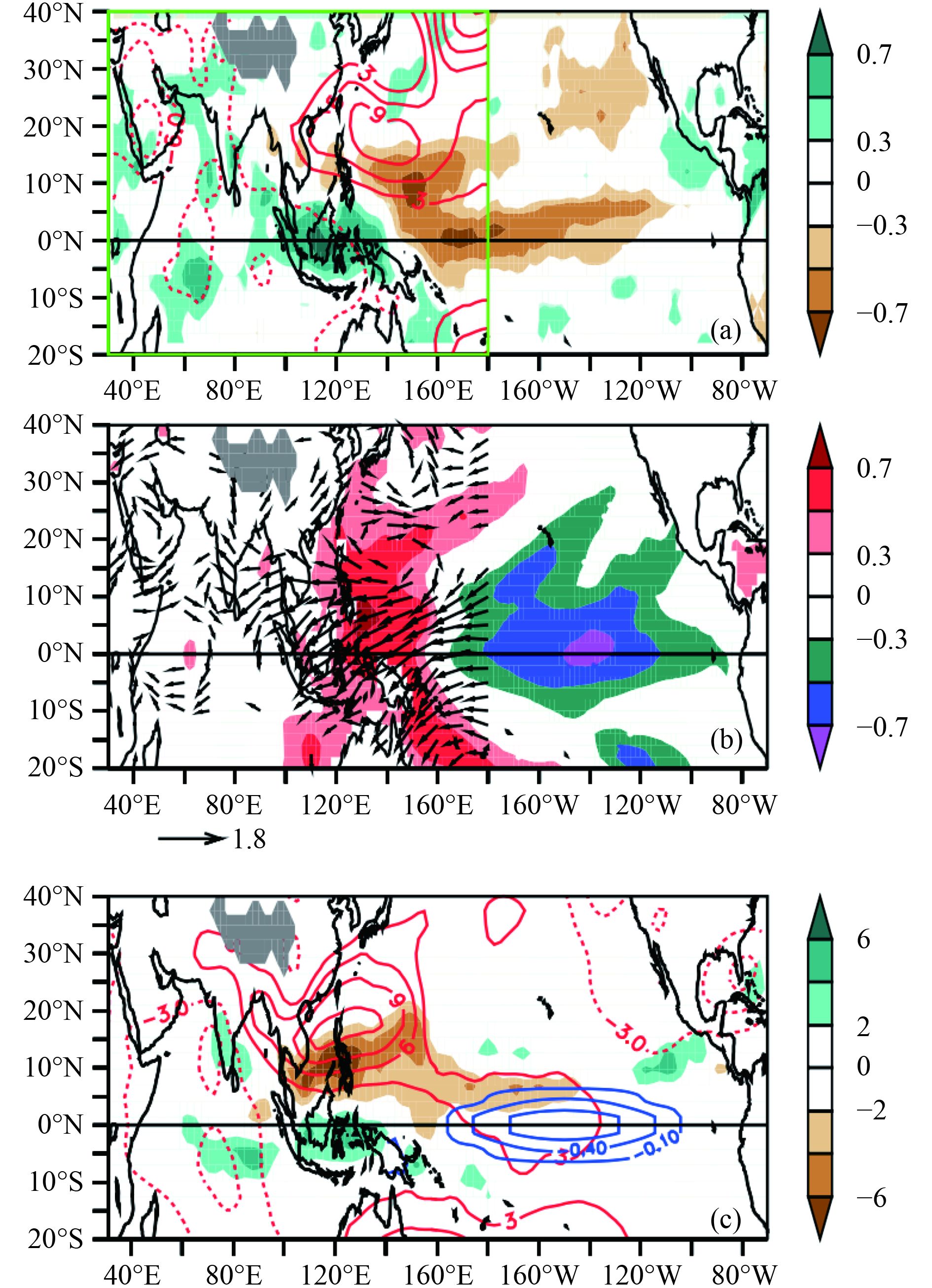
|
| Figure 19 The second EOF mode derived from summer (JJA) mean 850-hPa geopotential height (H850) in the Asian–Australian monsoon domain (20°S–40°N, 30°E–180°) for 1979–2009. (a) Spatial pattern (contour) and the correlated precipitation (shading) in the Indo-Pacific domain with correlations significant at 90% confidence (r > 0.3). (b) The correlated SSTA (shading) and 850-hPa wind anomalies with reference to the principal component of the EOF mode. (c) Simulated JJA H850 (contour, m) and precipitation (shading, mm day –1) anomalies using an AGCM model forced by a prescribed cold SSTA over the equatorial central Pacific (blue contour, °C). Adopted from Wang et al. (2013). |
The enhanced WNPAC associated with the second mode is arguably forced by the central Pacific cooling that shifts the east–west circulation (Walker) cell with the rising limb shifting westward, thus reducing convection around 160°E and increasing convection over the Maritime Continent (Fig. 19a). The suppressed convection can directly strengthen the WNPAC by emanation of descending Rossby waves. This assertion was confirmed by numerical experiments with an AGCM forced by the central Pacific SST cooling (Fig. 19c). Meanwhile, the reinforced Maritime Continent convection can also enhance the WNPAC via inducing equatorial easterlies over the western Pacific (Sui et al., 2007; Chung et al., 2011), which generates off-equatorial anticyclonic shear vorticity over the Philippine Sea. The main processes associated with this mechanism are summarized in the schematic diagram in Fig. 20.

|
| Figure 20 Schematic diagrams showing the WNPAC forced by a central Pacific cooling. Green (yellow) represents positive (negative) rainfall anomalies; black arrows represent low-level wind direction; and “A” in black indicates the anticyclonic circulation. Adopted from Wang et al. (2017). |
In summary, the central Pacific SSTA forcing may be regarded as an additional mechanism for the development of the WNPAC in summer. It can occur during either the rapid decaying of an El Niño episode or the developing/persisting phase of a La Niña. It is worth mentioning that although statistically the composite SST anomalies in the eastern equatorial Pacific are near normal during the El Niño decaying summer, the real situation varies from case to case depending upon the pace of El Niño decay—positive SST anomalies are maintained in persistent El Niño cases (such as 1986/87 episode), SST anomalies are near zero during normal decay cases, and negative SST anomalies develop in the cases when a transition from El Niño to La Niña occurs. A recent modeling study byChen Z.-S. et al. (2016) showed that during the rapid El Niño–La Niña transition, the central– eastern Pacific cooling plays an important role in maintaining the anomalous anticyclone in the WNP.
4 Discussion 4.1 What causes the onset of the WNPAC?An open issue is what is the role of high-frequency atmospheric process in triggering the WNPAC? One such fast atmospheric process is intraseasonal oscillation (ISO) (Wang and Zhang, 2002). Wang and Zhang (2002) showed that the transition from a negative sea level pressure anomaly to a persistent positive sea level pressure anomaly over the WNP is often accompanied by an ISO event. In a theoretical study, Wang and Xie (1998) suggested that the summer mean state favors the fluctuation of tropical perturbations on intraseasonal timescale while the winter mean state favors an instability and thus the persistence of the perturbation. The argument against this hypothesis is that the WNPAC can be generated in a model with weak ISO variability, as long as the El Niño forcing is present.
In contrast to the fast process above, slower processes that cause the formation of the WNPAC include the local air–sea interaction (Wang et al., 2000), eastward propagation of an anomalous low-level anticyclone from tropical IO (Chen et al., 2007), and moist enthalpy advection/Rossby wave modulation (Wu et al., 2017a, b).
The first slower process involves the development of a cold SSTA in the WNP. This process started during El Niño developing summer (Wu et al., 2010b), with a lo-cal acceleration of SSTA cooling twice prior to El Niño mature winter. As shown in Wang et al. (2003), the maintenance of the cold SSTA throughout the El Niño mature winter and succeeding spring is through surface latent heat flux and shortwave radiative flux anomalies.
The second slower process is associated with the eastward propagation of an anomalous low-level anticyclone (Chen et al., 2007). This anomalous anticyclone appears over the tropical IO during the El Niño developing summer. It propagates eastward and arrives in the SCS in northern fall and the WNP in northern winter. Chen et al. (2007) argued that the mechanism for the eastward propagation is attributed to anomalous dry advection east of the anticyclone.
The third slower process is associated with the moist enthalpy advection in late full/early winter (Wu et al., 2017a), which shifts from a positive to a negative advection because the seasonal mean gradient of the MSE changes its sign. Meanwhile, the eastward migration of the anomalous anticyclone in boreal winter is a result of seasonal change of the effective beta effect, which constrains the heating induced Rossby wave gyre to a smaller zonal extent.
What are the relative roles of fast atmospheric processes such as ISO and slower processes such as local SST change, eastward-propagating atmospheric circulation signals from the tropical IO, and moist enthalpy advection, in “triggering” the WNPAC? The answer is unclear so far. It is likely that the formation of the WNPAC might involve different processes for individual El Niño episodes. Sometimes it might arise from the combination of the different processes mentioned above.
4.2 A possible Atlantic capacitor effectPrevious studies showed that the El Niño may have a remote impact on SSTA in northern spring over tropical Atlantic (mostly north of the equator) (e.g., Klein et al., 1999; Saravanan and Chang, 2000; Alexander et al., 2002). Does the SSTA in the tropical Atlantic affect the circulation in the WNP? Rong et al. (2010) suggested that the Atlantic SSTA may remotely affect the wind in the WNP and modulate the ENSO–East Asian monsoon relationship through a Kelvin wave response. Ham et al. (2013) emphasized the Rossby wave response to tropical Atlantic heat source, which modulated the SSTA associated with the Pacific Meridional Mode (PMM; Chiang and Vimont, 2004) in the extratropical North Pacific. Yu et al. (2016) further argued that tropical Atlantic SSTA may modulate tropical cyclone activity in the WNP through an IO relay effect.
To clearly illustrate the Atlantic capacitor effect, we plotted the composite SST evolution patterns in global tropics from El Niño developing summer to its decaying summer. Note that statistically significant SSTA signal appears in tropical Atlantic during El Niño decaying spring and summer (Fig. 21). Meanwhile significant SSTA signal also appears in the tropical Indian Ocean, and an anticyclonic signal appears in the WNP from the El Niño mature winter to its decaying summer.
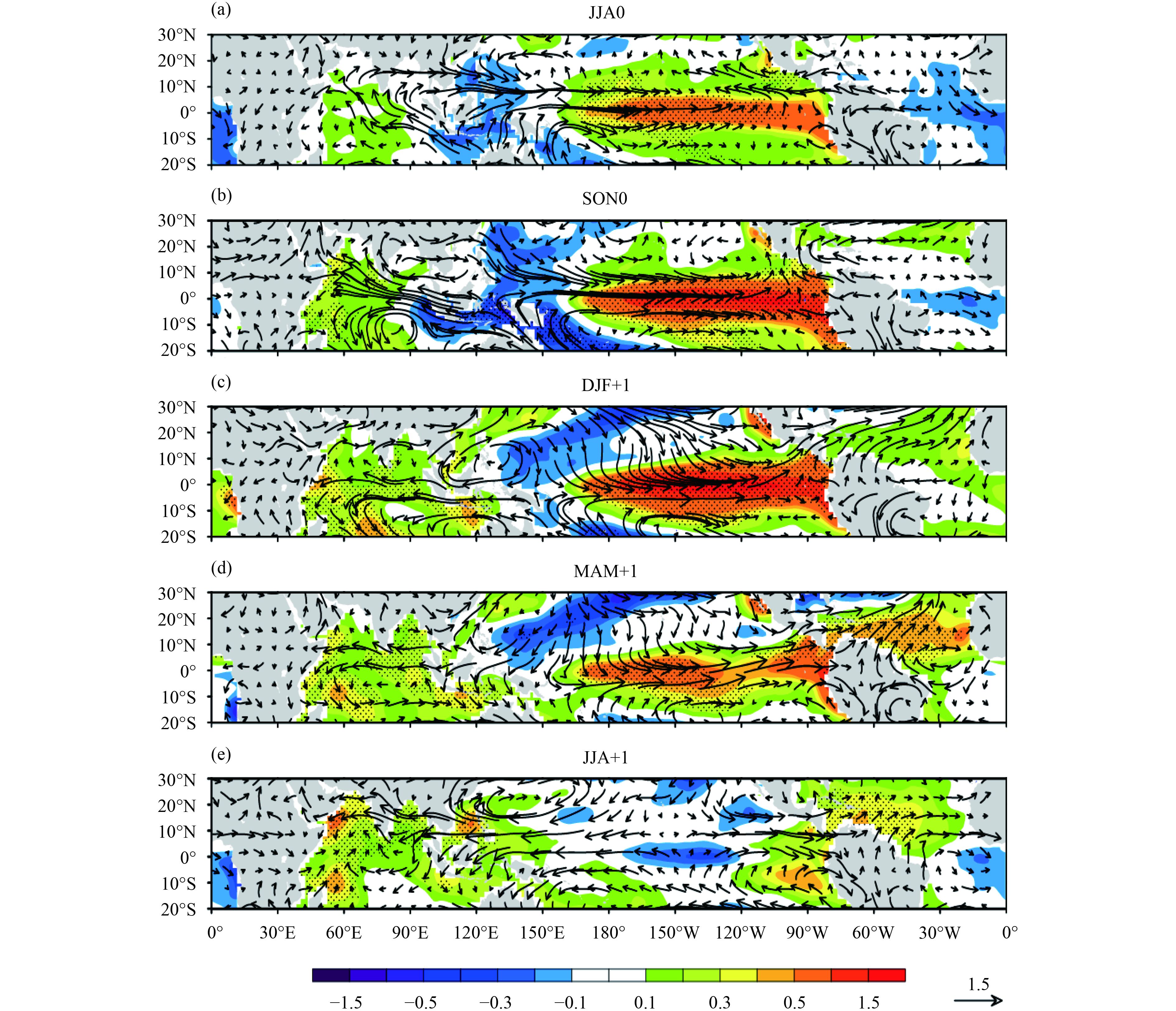
|
| Figure 21 Anomalous SST (shaded, °C) and 850-hPa wind (m s–1) fields regressed against the Niño 3.4 index for (a) JJS0, (b) SON0, (c) DJF+1, (d) MAM+1, and (e) JJA+1 of 1980–2015. Year 0 denotes El Niño developing year, and year +1 denotes El Niño decaying year. Dotted areas indicate that SSTA signals exceed the 95% confidence level. |
A lead–lag correlation analysis between the SSTA over the equatorial eastern Pacific (10°S–10°N, 180°–120°W) and the SSTA in the tropical Atlantic (5°–25°N, 80°–20°W) was conducted, and the result is shown in Fig. 22. Note that the Pacific leads the Atlantic by 3 months, which clearly indicates the El Niño impact on generating a warm SSTA in the tropical Atlantic in northern spring. Such a relationship is statistically significant, exceeding the 95% confidence level. It is also noted that a positive Atlantic SSTA also leads a negative SSTA in eastern Pacific by 6–9 months. This means that a positive SSTA in the Atlantic may promote the occurrence of a La Niña event through induced easterly anomaly at the equatorial Pacific. Such a relationship also exceeds the 95% confidence level.
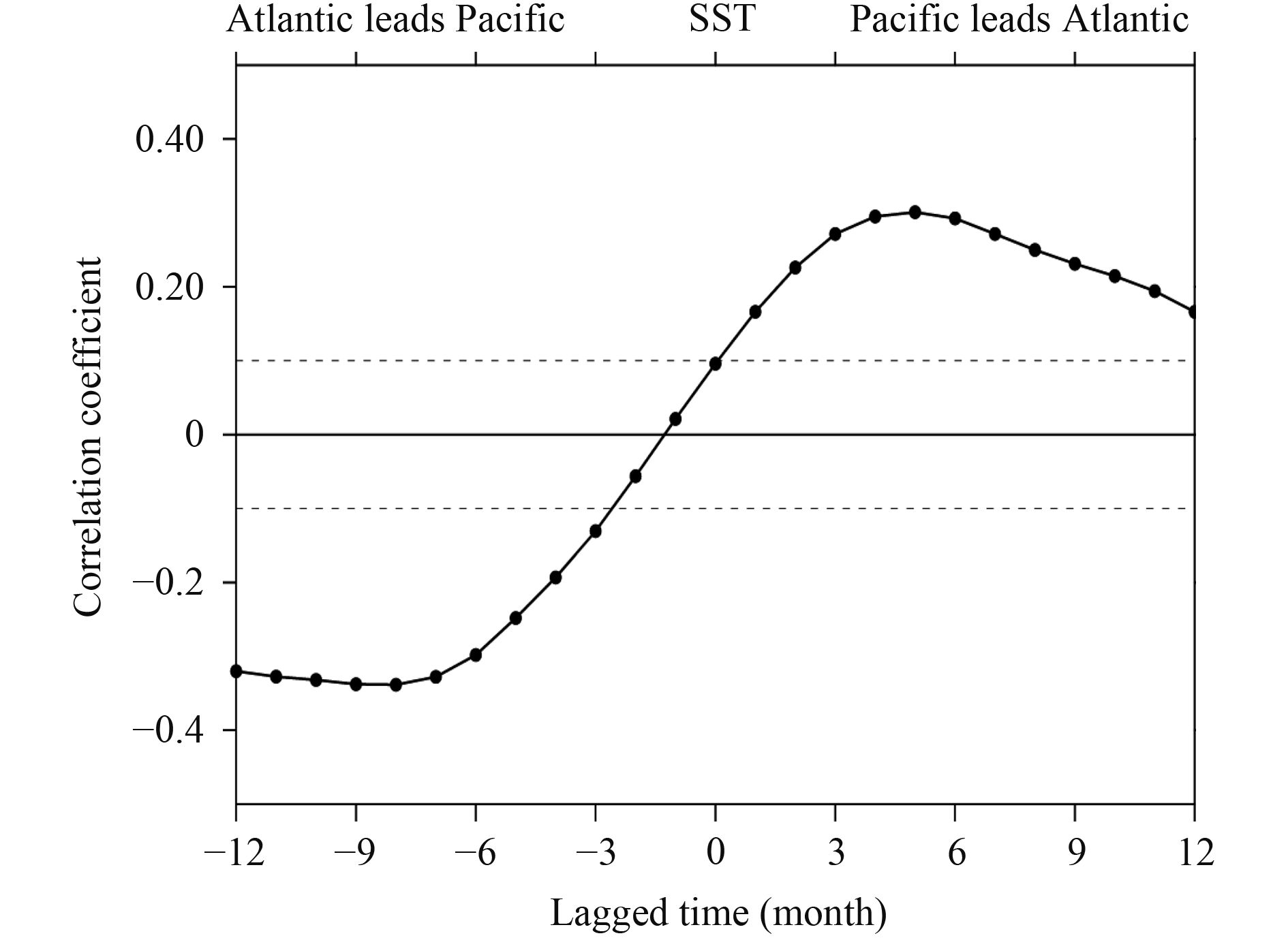
|
| Figure 22 Lead–lag correlations between SSTA (°C) averaged over eastern equatorial Pacific (180°–120°W, 10°S–10°N) and over the tropical Atlantic (80°–20°W, 5°–25°N) for the period of 1980–2015. Dashed line denotes the 95% confidence level. |
The observational analysis above suggests a possible tropical Atlantic capacitor effect in the maintenance of the WNPAC during El Niño decaying summer. In this scenario, the Atlantic SSTA is a result of El Niño forcing; in the meantime, it can remotely affect the WNP circulation through either a Kelvin wave response to its east or a Rossby wave response to its west. In the former, the anomalous wind may interact with the IO SST to have a relaying effect (Yu et al., 2016). In the latter, anomalous wind may interact with extratropical Pacific Ocean through an evaporation–wind–SST feedback (Ham et al., 2013).
5 ConclusionsIn this review paper, we summarize how the WNPAC was discovered in connecting El Niño and East Asian climate and how various theories were proposed in the past 20 years in an attempt to understand the formation and maintenance mechanisms of the WNPAC. Two sets of observational studies were conducted to reveal the role of the WNPAC in the ENSO–East Asia teleconnection. One was based on the rainfall variability in East Asia (e.g., Fu and Teng, 1988; Chang et al., 2000a, b). Another was based on the El Niño composite (e.g., Zhang et al., 1996; Wang et al., 2000).
So far, various theories have been proposed to understand the formation and maintenance of the WNPAC. The first is the warm pool atmosphere–ocean interaction theory that extends the original local atmosphere–ocean interaction of Wang et al. (2000) to a self-sustained interbasin coupled mode across the IO–WNP (Wang et al., 2013). The second is the Indian Ocean capacitor theory (Xie et al., 2009; Wu et al., 2009). The third is the combination mode theory (Stuecker et al., 2015). The fourth is the moist enthalpy advection/Rossby wave modulation theory (Wu et al., 2017a, b). The fifth is the central Pacific SSTA forcing theory (Wang et al., 2013; Xiang et al., 2013).
Table 1 summarizes all relevant mechanisms operating at different phases of ENSO. The main mechanisms responsible for the initial development of the WNPAC prior to El Niño peak winter are the local atmosphere–ocean interaction (Wang et al., 2000) and the moist enthalpy advection/Rossby wave modulation (Wu et al., 2017a, b). The above two mechanisms are also responsible for the maintenance of the WNPAC from El Niño mature winter to subsequent spring. During the El Niño decaying summer, the WNPAC is influenced by both the local SSTA in the WNP (Wu et al., 2010a) and the remote SSTA from the tropical IO (Wu et al., 2009; Xie et al., 2009). The central Pacific cold SSTA appears important during the summers of rapid El Niño decaying or La Niña developing/persistence. The near-annual periods predicted by the combination mode theory are hardly detected from the observations and its amplitude is much weaker compared to the observed. As a result, its contribution to formation of the WNPAC is unclear.
| ENSO phase | Key processes responsible for formation and maintenance of WNPAC |
| El Niño developing fall SON(0)
El Niño mature winter DJF(1) El Niño decaying spring MAM(1) |
|
| El Niño decaying summer JJA(1) |
|
| La Niña developing or persisting summer JJA | Central Pacific SSTA forcing (Wang et al., 2013; Xiang et al., 2013) |
A new mechanism, the tropical Atlantic capacitor effect, is proposed. The SSTA in the tropical Atlantic, on one hand, is a result of El Niño forcing, and on the other hand, may exert a remote impact on the WNP circulation during El Niño decaying summer. Two possible routes may be involved. One is an eastward route through heating induced Kelvin wave response, with or without an Indian Ocean relaying effect (Rong et al., 2010; Yu et al., 2016; Zhang et al., 2017). Another is a westward route through heating induced Rossby wave response, in which air–sea interaction in extratropical North Pacific is criti-cal (Ham et al., 2013).
While great progress has been made in the past 20 years in understanding the dynamics of the WNPAC, some important issues remain open. For example, the actual impact of the IO SSTA on the WNPAC remains a controversy. On one hand, the El Niño composite (regardless of El Niño intensity) does show a basin-wide warming and associated basin-wide ascending motion and positive precipitation anomalies in boreal summer over the IO. On the other hand, the EOF analysis based on summertime H850 analysis (Wang et al., 2013) shows that the WNPAC is associated with an IO warming in the first EOF mode but such a warming is not accompanied by a significant positive rainfall anomaly, whereas the second mode is not accompanied by the IO warming at all. This raises the question about the IO SSTA effect. Another issue is about the maintenance of the WNPAC in northern spring. While the all El Niño composite maps (Fig. 5) show the continuous WNPAC pattern throughout El Niño decaying phase, a composite analysis that separates strong and weak El Niño groups (figure omitted) reveals that the WNPAC is hardly seen in the weak El Niño composite during its decaying spring. Local V-shaped SSTA appears weak too. This raises questions about fundamental physical processes operated in regulating atmospheric circulation anomalies and underlying SSTA and their distinctive differences between the strong and weak El Niño groups. Therefore, further in-depth observational and modeling studies are needed to understand the IO SSTA effect, the relative roles of remote versus local processes, and internal atmospheric dynamics versus coupled atmosphere–ocean interaction processes in affecting the WNP circulation anomalies.
| Alexer, M. A., I. Blade, M. Newman, et al., 2002: The atmospheric bridge: The influence of ENSO teleconnections on air–sea interaction over the global oceans. J. Climate, 15, 2205–2231. DOI:10.1175/1520-0442(2002)015<2205:TABTIO>2.0.CO;2 |
| Chang, C.-P., and T. Li, 2000: A theory for the tropical tropospheric biennial oscillation. J. Atmos. Sci., 57, 2209–2224. DOI:10.1175/1520-0469(2000)057<2209:ATFTTT>2.0.CO;2 |
| Chang, C.-P., Y. S. Zhang, and T. Li, 2000a: Interannual and interdecadal variations of the East Asian summer monsoon and tropical Pacific SSTs. Part I: Roles of the subtropical ridge. J. Climate, 13, 4310–4325. DOI:10.1175/1520-0442(2000)013<4310:IAIVOT>2.0.CO;2 |
| Chang, C.-P., Y. S. Zhang, and T. Li, 2000b: Interannual and interdecadal variations of the East Asian summer monsoon and tropical Pacific SSTs. Part II: Meridional structure of the monsoon. J. Climate, 13, 4326–4340. DOI:10.1175/1520-0442(2000)013<4326:IAIVOT>2.0.CO;2 |
| Chen, J.-M., T. Li, and C.-F. Shih, 2007: Fall persistence barrier of sea surface temperature in the South China Sea associated with ENSO. J. Climate, 20, 158–172. DOI:10.1175/JCLI4000.1 |
| Chen, M.-C., T. Li, X.-Y. Shen, et al., 2016: Relative roles of dynamic and thermodynamic processes in causing evolution asymmetry between El Niño and La Niña. J. Climate, 29, 2201–2220. DOI:10.1175/JCLI-D-15-0547.1 |
| Chen, Z.-S., Z.-P. Wen, R. G. Wu, et al., 2016: Relative importance of tropical SST anomalies in maintaining the western North Pacific anomalous anticyclone during El Niño to La Niña transition years. Climate Dyn., 46, 1027–1041. DOI:10.1007/s00382-015-2630-1 |
| Chiang, J. C. H., and D. J. Vimont, 2004: Analogous Pacific and Atlantic meridional modes of tropical atmosphere–ocean variability. J. Climate, 17, 4143–4158. DOI:10.1175/JCLI4953.1 |
| Chou, C., 2004: Establishment of the low-level wind anomalies over the western North Pacific during ENSO development. J. Climate, 17, 2195–2212. DOI:10.1175/1520-0442(2004)017<2195:EOTLWA>2.0.CO;2 |
| Chung, P. H., C. H. Sui, and T. Li, 2011: Interannual relationships between the tropical sea surface temperature and summertime subtropical anticyclone over the western North Pacific. J. Geophys. Res., 16, D13111. DOI:10.1029/2010JD015554 |
| Fu, C. B., and X. L. Teng, 1988: Climate anomalies in China associated with E1 Niño/Southern Oscillation. Chinese J. Atmos. Sci., 12, 133–141. DOI:10.3878/j.issn.1006-9895.1988.t1.11 |
| Gill, A. E., 1980: Some simple solutions for heat-induced tropical circulation. Quart. J. Roy. Meteor. Soc., 106, 447–462. DOI:10.1002/qj.49710644905 |
| Gong, D. Y., and C. H. Ho, 2002: Shift in the summer rainfall over the Yangtze River valley in the late 1970s. Geophys. Res. Lett., 29, 1436. DOI:10.1029/2001GL014523 |
| Gu, D. J., T. Li, Z. P. Ji, et al., 2010: On the phase relations between the western North pacific, Indian, and Australian monsoons. J. Climate, 23, 5572–5589. DOI:10.1175/2010JCLI2761.1 |
| Ham, Y.-G., J.-S. Kug, J.-Y. Park, et al., 2013: Sea surface temperature in the north tropical Atlantic as a trigger for El Niño/Southern Oscillation events. Nature Geoscience, 6, 112–116. DOI:10.1038/ngeo1686 |
| Hong, C.-C., T. Li, H. Lin, et al., 2010: Asymmetry of the Indian Ocean basinwide SST anomalies: Roles of ENSO and IOD. J. Climate, 23, 3563–3576. DOI:10.1175/2010JCLI3320.1 |
| Hoskins, B. J., and D. J. Karoly, 1981: The steady linear response of a spherical atmosphere to thermal and orographic forcing. J. Atmos. Sci., 38, 1179–1196. DOI:10.1175/1520-0469(1981)038<1179:TSLROA>2.0.CO;2 |
| Hu, Z. Z., 1997: Interdecadal variability of summer climate over East Asia and its association with 500-hPa height and global sea surface temperature. J. Geophys. Res., 102, 19403–19412. DOI:10.1029/97JD01052 |
| Huang, R. H., and Y. F. Wu, 1989: The influence of ENSO on the summer climate change in China and its mechanism. Adv. Atmos. Sci., 6, 21–32. DOI:10.1007/BF02656915 |
| Jiang, X. A., and T. Li, 2005: Reinitiation of the boreal summer intraseasonal oscillation in the tropical Indian Ocean. J. Climate, 18, 3777–3795. DOI:10.1175/JCLI3516.1 |
| Klein, S. A., B. J. Soden, and N.-C. Lau, 1999: Remote sea surface temperature variations during ENSO: Evidence for a tropical atmospheric bridge. J. Climate, 12, 917–932. DOI:10.1175/1520-0442(1999)012<0917:RSSTVD>2.0.CO;2 |
| Lau, N.-C., and M. J. Nath, 2003: Atmosphere–ocean variations in the Indo-Pacific sector during ENSO episodes. J. Climate, 16, 3–20. DOI:10.1175/1520-0442(2003)016<0003:AOVITI>2.0.CO;2 |
| Lau, N.-C., and B. Wang, 2006: Interactions between the Asian monsoon and the El Niño/Southern Oscillation. The Asian Monsoon, Wang, B. Ed., Springer/Praxis Publishing, New York, 478–512. |
| Lau, N. C., A. Leetmaa, and M. J. Nath, 2006: Attribution of atmospheric variations in the 1997–2003 period to SST anomalies in the Pacific and Indian Ocean basins. J. Climate, 19, 3607–3628. DOI:10.1175/JCLI3813.1 |
| Li, S. L., J. Lu, G. Huang, et al., 2008: Tropical Indian Ocean basin warming and East Asian summer monsoon: A multiple AGCM study. J. Climate, 21, 6080–6088. DOI:10.1175/2008JCLI2433.1 |
| Li, T., 2006: Origin of the summertime synoptic-scale wave train in the western North Pacific. J. Atmos. Sci., 63, 1093–1102. DOI:10.1175/JAS3676.1 |
| Li, T., 2010: Monsoon climate variabilities. Climate Dynamics: Why Does Climate Vary? Sun, D. Z., and F. Bryan, Eds., American Geophysical Union, Washington DC, doi: 10.1029/2008GM000782. |
| Li, T. 2012: Synoptic and climatic aspects of tropical cyclogenesis in western North Pacific. Cyclones: Formation, Triggers and Control, Oouchi, K., and H. Fudeyasu, Eds., Nova Science Publishers, Inc., Hauppauge, NY, 61–94. |
| Li, T., and B. Wang, 2005: A review on the western North Pacific monsoon: Synoptic-to-interannual variabilities. Terr. Atmos. Oceanic Sci., 16, 285–314. DOI:10.3319/TAO.2005.16.2.285(A) |
| Li, T., and P.-C. Hsu, 2017: Monsoon dynamics and its interactions with ocean. Fundamentals of Tropical Climate Dynamics, Springer International Publishing, Cham, 236 pp, doi: 10.1007/978-3-319-59597-9. |
| Li, T., B. Wang, C.-P. Chang, et al., 2003: A theory for the Indian Ocean dipole-zonal mode. J. Atmos. Sci., 60, 2119–2135. DOI:10.1175/1520-0469(2003)060<2119:ATFTIO>2.0.CO;2 |
| Li, T., P. Liu, X. Fu, et al., 2006: Spatiotemporal structures and mechanisms of the tropospheric biennial oscillation in the Indo-Pacific warm ocean regions. J. Climate, 19, 3070–3087. DOI:10.1175/JCLI3736.1 |
| Li, T., B. Wang, and L. Wang, 2016: Comments on " Combination mode dynamics of the anomalous Northwest Pacific anticyclone”. J. Climate, 29, 4685–4693. DOI:10.1175/JCLI-D-15-0385.1 |
| Liu, J., B. Wang, and J. Yang, 2008: Forced and internal modes of variability of the East Asian summer monsoon. Climate of the Past, 4, 225–233. DOI:10.5194/cp-4-225-2008 |
| Meehl, G. A., 1987: The annual cycle and interannual variability in the tropical Pacific and Indian Ocean regions. Mon. Wea. Rev., 115, 27–50. DOI:10.1175/1520-0493(1987)115<0027:TACAIV>2.0.CO;2 |
| Neelin, J. D., and I. M. Held, 1987: Modeling tropical convergence based on the moist static energy budget. Mon. Wea. Rev., 115, 3–12. DOI:10.1175/1520-0493(1987)115<0003:MTCBOT>2.0.CO;2 |
| Philander, S. G. H., 1990: El Niño, La Niña, and the Southern Oscillation. Academic Press, London, 289 pp. |
| Rasmusson, E. M., and T. H. Carpenter, 1982: Variations in tropical sea surface temperature and surface wind fields associated with the Southern Oscillation/El Niño. Mon. Wea. Rev., 110, 354–384. DOI:10.1175/1520-0493(1982)110<0354:VITSST>2.0.CO;2 |
| Roeckner, E., K. Arpe, L. Bengtsson, et al., 1996: The Atmosphe-ric General Circulation Model ECHAM-4: Model Description and Simulation of Present-Day Climate. Max-Planck-Institute for Meteorology Rep. 218, Max-Planck-Institut für Meteorologie, 90 pp. [Available online at http://www.mpimet.mpg.de/fileadmin/publikationen/Reports/] |
| Rong, X. Y., R. H. Zhang, and T. Li, 2010: Impacts of Atlantic sea surface temperature anomalies on Indo-East Asian summer monsoon–ENSO relationship. Chinese Sci. Bull., 55, 2458–2468. DOI:10.1007/s11434-010-3098-3 |
| Saravanan, R., and P. Chang, 2000: Interaction between tropical Atlantic variability and El Niño–Southern Oscillation. J. Climate, 13, 2177–2194. DOI:10.1175/1520-0442(2000)013<2177:IBTAVA>2.0.CO;2 |
| Shen, S., and K.-M. Lau, 1995: Biennial oscillation associated with the East Asian summer monsoon and tropical sea surface temperatures. J. Meteor. Soc. Japan, 73, 105–124. DOI:10.2151/jmsj1965.73.1_105 |
| Stuecker, M. F., F.-F. Jin, A. Timmermann, et al., 2015: Combination mode dynamics of the anomalous Northwest Pacific anticyclone. J. Climate, 28, 1093–1111. DOI:10.1175/JCLI-D-14-00225.1 |
| Sui, C.-H., P. H. Chung, and T. Li, 2007: Interannual and interdecadal variability of the summertime western North Pacific subtropical high. Geophys. Res. Lett., 34, L11701. DOI:10.1029/2006GL029204 |
| Tao, S. Y., and L. X. Chen, 1987: A review of recent research on the East Asian summer monsoon in China. Monsoon Meteorology, Chang, C.-P., and T. N. Krishramuti, Eds., Oxford University Press, Oxford, 60–92. |
| Tao, S. Y., and Q. Y. Zhang, 1998: Response of the Asian winter and summer monsoon to ENSO events. Sci. Atmos. Sinica, 22, 399–407. DOI:10.3878/j.issn.1006-9895.1998.04.02 |
| Wallace, J. M., and D. S. Gutzler, 1981: Teleconnections in the geopotential height field during the Northern Hemisphere winter. Mon. Wea. Rev., 109, 784–812. DOI:10.1175/1520-0493(1981)109<0784:TITGHF>2.0.CO;2 |
| Wang, B., and X. S. Xie, 1998: Coupled modes of the warm pool climate system. Part I: The role of air–sea interaction in maintaining Madden–Julian Oscillation. J. Climate, 11, 2116–2135. DOI:10.1175/1520-0442-11.8.2116 |
| Wang, B., and J. C. L. Chan, 2002: How strong ENSO events affect tropical storm activity over the western North Pacific. J. Climate, 15, 1643–1658. DOI:10.1175/1520-0442(2002)015<1643:HSEEAT>2.0.CO;2 |
| Wang, B., and Q. Zhang, 2002: Pacific–East Asian teleconnection. Part II: How the Philippine Sea anomalous anticyclone is established during El Niño development. J. Climate, 15, 3252–3265. DOI:10.1175/1520-0442(2002)015<3252:PEATPI>2.0.CO;2 |
| Wang, B., and T. Li, 2004: East Asian monsoon and ENSO interaction. East Asian Monsoon, C.-P. Chang, Ed., World Scientific Publishing, Singapore, 172-212. |
| Wang, B., R. G. Wu, and X. H. Fu, 2000: Pacific–East Asian teleconnection: How does ENSO affect East Asian climate?. J. Climate, 13, 1517–1536. DOI:10.1175/1520-0442(2000)013<1517:PEATHD>2.0.CO;2 |
| Wang, B., R. G. Wu, and T. Li, 2003: Atmosphere–warm ocean interaction and its impacts on Asian–Australian monsoon variation. J. Climate, 16, 1195–1211. DOI:10.1175/1520-0442(2003)16<1195:AOIAII>2.0.CO;2 |
| Wang, B., Q. H. Ding, X. H. Fu, et al., 2005: Fundamental challenge in simulation and prediction of summer monsoon rainfall. Geophys. Res. Lett., 32, L15711. DOI:10.1029/2005GL02273412 |
| Wang, B., B. Q. Xiang, and J.-Y. Lee, 2013: Subtropical high predictability establishes a promising way for monsoon and tropical storm predictions. Proc. Natl. Acad. Sci. USA, 110, 2718–2722. DOI:10.1073/pnas.1214626110 |
| Wang, B., J. Li, and Q. He, 2017: Variable and robust East Asian monsoon rainfall response to El Niño over the past 60 years (1957–2016). Adv. Atmos. Sci., 34, 1235–1248. DOI:10.1007/s00376-017-7016-3 |
| Watanabe, M., and F.-F. Jin, 2002: Role of Indian Ocean warming in the development of Philippine Sea anticyclone during ENSO. Geophys. Res. Lett., 29, 1478. DOI:10.1029/2001GL014318 |
| Webster, P. J., and S. Yang, 1992: Monsoon and ENSO: Selectively interactive systems. Quart. J. Roy. Meteor. Soc., 118, 877–926. DOI:10.1002/qj.49711850705 |
| Webster, J., O. Magaña P., N. Palmer V., et al., 1998: Monsoons: Processes, predictability, and the prospects for prediction. J. Geophys. Res., 103, 14451–14510. DOI:10.1029/97JC02719 |
| Wu, R. G., Z.-Z. Hu, and B. P. Kirtman, 2003: Evolution of ENSO-related rainfall anomalies in East Asia. J. Climate, 16, 3742–3758. DOI:10.1175/1520-0442(2003)016<3742:EOERAI>2.0.CO;2 |
| Wu, R. G., B. P. Kirtman, and V. Krishnamurthy, 2008: An asymmetric mode of tropical Indian Ocean rainfall variability in boreal spring. J. Geophys. Res., 113, D05104. DOI:10.1029/2007JD009316 |
| Wu, B., T. J. Zhou, and T. Li, 2009: Seasonally evolving dominant interannual variability modes of East Asian climate. J. Climate, 22, 2992–3005. DOI:10.1175/2008JCLI2710.1 |
| Wu, B., T. Li, and T. Zhou, 2010a: Relative contributions of the Indian Ocean and local SST anomalies to the maintenance of the western North Pacific anomalous anticyclone during the El Niño decaying summer. J. Climate, 23, 2974–2986. DOI:10.1175/2010JCLI3300.1 |
| Wu, B., T. Li, and T. Zhou, 2010b: Asymmetry of atmospheric circulation anomalies over the western North Pacific between El Niño and La Niña. J. Climate, 23, 4807–4822. DOI:10.1175/2010JCLI3222.1 |
| Wu, B., T. J. Zhou, and T. Li, 2017a: Atmospheric dynamic and thermodynamic processes driving the western North Pacific anomalous anticyclone during El Niño. Part I: Maintenance mechanisms. J. Climate, 30, 9621–9635. DOI:10.1175/JCLI-D-16-0489.1 |
| Wu, B., T. J. Zhou, and T. Li, 2017b: Atmospheric dynamic and thermodynamic processes driving the western North Pacific anomalous anticyclone during El Niño. Part II: Formation processes. J. Climate, 30, 9637–9650. DOI:10.1175/JCLI-D-16-0495.1 |
| Wu, P., Y. H. Ding, and Y. J. Liu, 2017: A new study of El Niño impacts on summertime water vapor transport and rainfall in China. Acta Meteor. Sinica, 75, 371–383. DOI:10.11676/qxxb2017.033 |
| Xiang, B. Q., B. Wang, W. D. Yu, et al., 2013: How can anomalous western North Pacific subtropical high intensify in late summer?. Geophys. Res. Lett., 40, 2349–2354. DOI:10.1002/grl.50431 |
| Xie, S.-P., K. M. Hu, J. Hafner, et al., 2009: Indian Ocean capaci-tor effect on Indo–western Pacific climate during the summer following El Niño. J. Climate, 22, 730–747. DOI:10.1175/2008JCLI2544.1 |
| Yang, J. L., Q. Y. Liu, S.-P. Xie, et al., 2007: Impact of the Indian Ocean SST basin mode on the Asian summer monsoon. Geophys. Res. Lett., 34, L02708. DOI:10.1029/2006GL028571 |
| Yu, J. H., T. Li, Z. M. Tan, et al., 2016: Effects of tropical North Atlantic SST on tropical cyclone genesis in the western North Pacific. Climate Dyn., 46, 865–877. DOI:10.1007/s00382-015-2618-x |
| Zhang, R. H., A. Sumi, and M. Kimoto, 1996: Impact of El Niño on the East Asian monsoon: A diagnostic study of the ’86/87 and ’91/92 events. J. Meteor. Soc. Japan, 74, 49–62. DOI:10.2151/jmsj1965.74.1_49 |
| Zhang, R. H., A. Sumi, and M. Kimoto, 1999: A diagnostic study of the impact of El Niño on the precipitation in China. Adv. Atmos. Sci., 16, 229–241. DOI:10.1007/BF02973084 |
| Zhang, R. H., Q. Min, and J. Z. Su, 2017: Impact of El Niño on atmospheric circulations over East Asia and rainfall in China: Role of the anomalous western North Pacific anticyclone. Sci. China Earth Sci., 60, 1124–1132. DOI:10.1007/s11430-016-9026-x |
| Zhou, T. J., D. Y. Gong, J. Li, et al., 2009a: Detecting and understanding the multi-decadal variability of the East Asian Summer Monsoon—Recent progress and state of affairs. Meteor. Z., 18, 455–467. DOI:10.1127/0941-2948/2009/0396 |
| Zhou, T. J., R. C. Yu, J. Zhang, et al., 2009b: Why the western Pacific subtropical high has extended westward since the late 1970s?. J. Climate, 22, 2199–2215. DOI:10.1175/2008JCLI2527.1 |
| Zhu, Z. W., and T. Li, 2016: A new paradigm for continental U.S. summer rainfall variability: Asia–North America teleconnection. J. Climate, 29, 7313–7327. DOI:10.1175/JCLI-D-16-0137.1 |
 2017, Vol. 31
2017, Vol. 31


